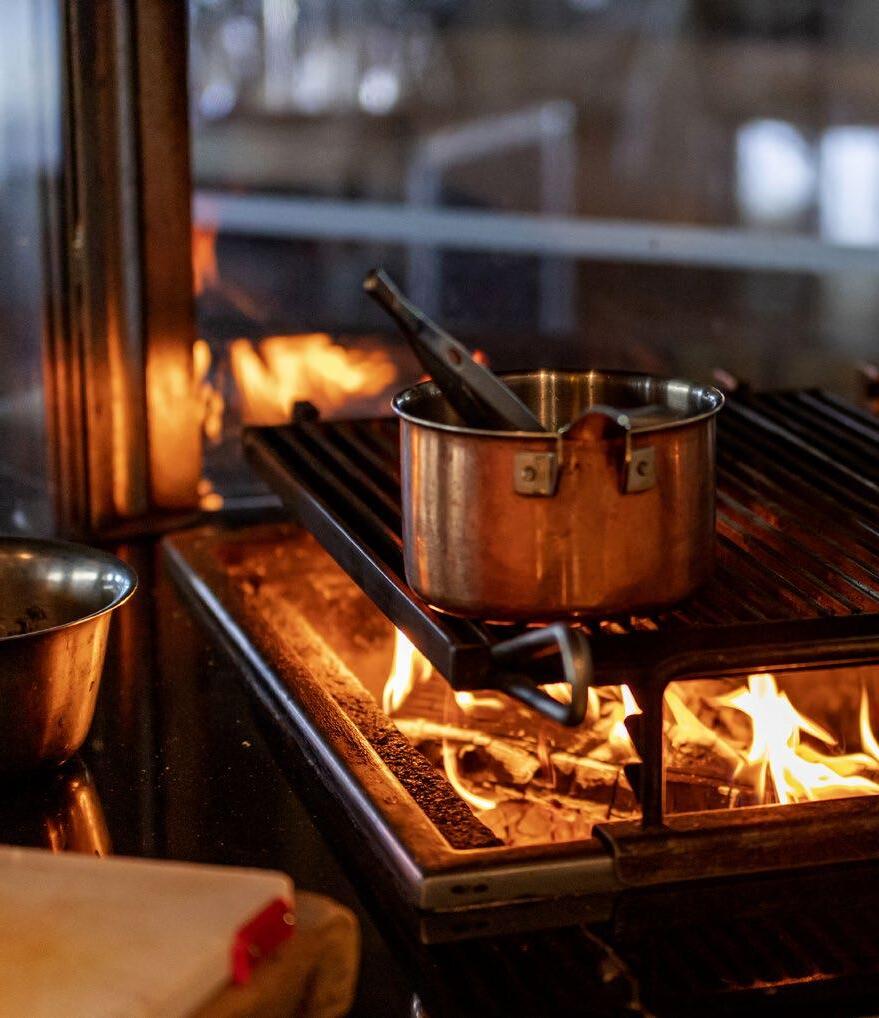

Food&Wine
Flavours of excellence between Monte Rosa, the Lakes and the Lands of Northern Piedmont
Between Monte Rosa, the Lakes and the Lands of Northern Piedmont
Territories to discover, able to give unexpected emotions
In the north of Piedmont, at the footsteps of the Alps and at short distance from Milan and Turin, a unique territory unfolds from the Novara and Vercelli plains through hills dotted with vineyards, where precious Nebbiolo wines are produced, and picturesque Lakes Maggiore, Orta and Mergozzo until reaching the alpine peaks of Biella, Valsesia and Ossola Valleys, dominated by Monte Rosa. The Lands and Lakes of Northern Piedmont are ready to welcome visitors with unique scenarios, breathtaking landscapes and a perfect combination of delicious local food, cultural attractions, outdoor experiences and intact nature.
The Biellese area is an unexpected natural jewel, with an extraordinary vocation for outdoor activities and rich in artistic and cultural attractions. Nature, outdoor sports, art, culture, textile entrepreneurship, and typical flavours under the banner of genuine authenticity: these are the main elements that describe the Province of Biella, a showcase of landscapes between plains, hills, and mountains. UNESCO sites, old villages, and the food and wine excellences complete the picture of a multifaceted territory with truly much to discover.
A land of rice, of wine, of immense horizons and breathtaking views, where nature meets art, the outdoors walks hand in hand with wine and food, and every element blends in a cultural and touristic offer to satisfy all tastes at any moment throughout the year. Novara is all of this, and so much more. It is a land to discover calmly, away from the maddening crowds yet at the heart of highquality events, a crossroads of art itineraries bearing the clear architectural imprinting of Alessandro Antonelli; of routes in the vineyards, the woods or along the roads of the rice paddies, to be followed on foot or by bike but always with the peace and quiet that these places require – fuelled by a risotto, a few slices of salami, Gorgonzola and a glass of good wine of Alto Piemonte.
The province of Vercelli with its incredible views stretches from the rice-growing plains surrounding Vercelli, through the rolling hills of Gattinara to the green valleys
of Valsesia, just a stone’s throw from Monte Rosa. It is a paradise for outdoor activities: the ideal place to spend time enjoying breathtaking alpine landscapes, discovering medieval villages and UNESCO sites, strolling through alpine valleys and marvelling at the incredible cultural heritage of historic towns.
Unspoilt nature, breathtaking landscapes, delightful valleys crossed by crystal clear streams, mountain villages that retain the features of local art, architecture and tradition: Valsesia is all this and much more!
The richness and variety of the natural environment makes Valsesia an ideal destination for lovers of active holidays: from mountaineering and trekking enthusiasts to those seeking adventure. Discover charming historic villages, beautiful natural sites and some of the highest peaks in Europe and marvel at the beauty of the valleys of Valsesia! The province of Vercelli presents itself as a rich and varied territory, with very different characteristics to discover crossing it from north to south. From a landscape point of view, one goes, in fact, in a short time from the paddy fields of the Po Valley to the hills of the Gattinara area, to reach the preAlpine environment of Valsesia and go as far as the Alps. These are all different lands, which over time brought about the development of cultures, production activities, unique traditions, and customs, yet influenced by each other, in a continuous relationship and sharing of common cultural roots.
From famous Lake Maggiore with the enchanting Borromeo Islands, the elegant villas, and lush gardens to the clear waters of peaceful Lake Mergozzo up to the charming scenery of Lake Orta with the Island of San Giulio: jewels of nature, art and history give these places an all-Italian “Dolce Vita” atmosphere. All around the Ossola Valleys which, among woods, lakes and pastures - offer mountain lovers the spectacle of Monte Rosathe second peak of the Alps - the Toce waterfall - with a drop of 143 metres - the Val Grande National Park or the largest wilderness area in Italy - and the uncontaminated nature of the Veglia Devero and Alta Valle Antrona Natural Parks. In just over an hour… from the Mediterranean allure of the lakes to the snow of the Alps!
VERCELLI
PIEMONTE
CUNEO
ORTA SAN GIULIO

APPETIZER
Capunèt
Recipe for 10 persons
Ingredients
• 300 g salami paste
• 200 g Swiss chard leaves
• 100 g stale white bread
• 100 g butter
• 50 g milk
• 50 g grated Parmigiano Reggiano cheese
• 20 g fresh thyme
• 1 whole egg
Preparation
Soften the bread in water. Briefly cook the salami paste to remove some of the fat. Blanch the chard leaves in salted water and lay them out to dry on a tea towel. Mix the softened bread with the salami paste, Parmigiano Reggiano cheese, thyme, and egg until smooth. Place small mounds of the mixture in the centre of each leaf, roll them up to fully enclose the filling, securing with a toothpick if needed. Fry them in foaming butter. Serve the capunèt on hot plates, accompanied by a properly thickened roast gravy. You can also use cabbage or lavassa leaves (a wild plant commonly found in the humid areas of Alta Valsesia).
Valsesia
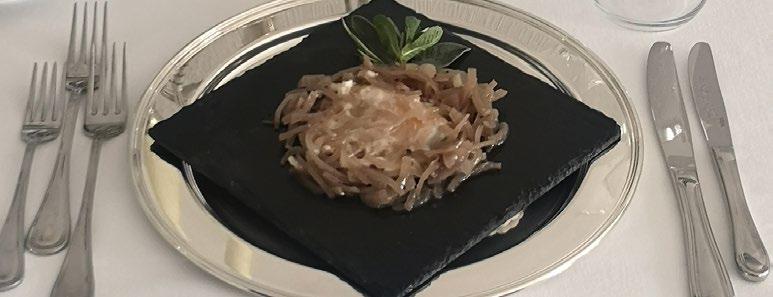
Cirighit
Sunny-side up fried eggs with a carpione-style marinade
Recipe for 4 persons
Ingredients
• 4 eggs
• 200 g yellow onions
• 150 ml red wine vinegar
• 100 ml water
• 50 g butter
• 20 ml extra virgin olive oil
• 8 sage leaves
• Fine salt
Preparation
Clean the onions and cut them into julienne strips. Slice the sage leaves. Heat the olive oil in a pan and sauté the onions. Add salt and the sage. Pour in the vinegar and water, bring to a boil, and simmer over low heat for 20 minutes. Melt the butter in another pan and cook the eggs sunny-side up with a pinch of salt, until the whites are set. Remove with a slotted spoon and place in a baking dish. Cover with the lukewarm carpione marinade. Let cool, cover with foil, and refrigerate overnight. Once marinated, place the eggs on serving plates, top with the onions, and serve.
Biella
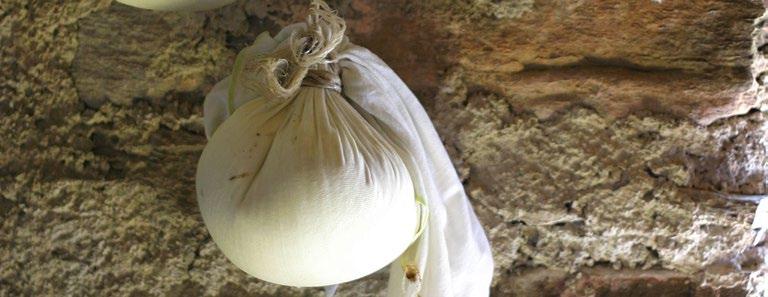
APPETIZER
Frachet
Recipe for 10 persons
Ingredients
• 600 g fresh, dry Tomino cheese
• 30 g grappa (mountain liqueur)
• 5 g pepper
• 10 g salt
• Garlic (optional)
• Spices (optional)
Preparation
Mash the cheese with a fork until creamy. Add the grappa and mix for a few more minutes. Mix thoroughly the salt, pepper, and optional ingredients such as crushed garlic or spices. Let it rest for several hours or overnight if possible. Alternatively, wrap the cheese mixture in a cloth and leave it to dry in the sun, following traditional rural methods.
Valsesia
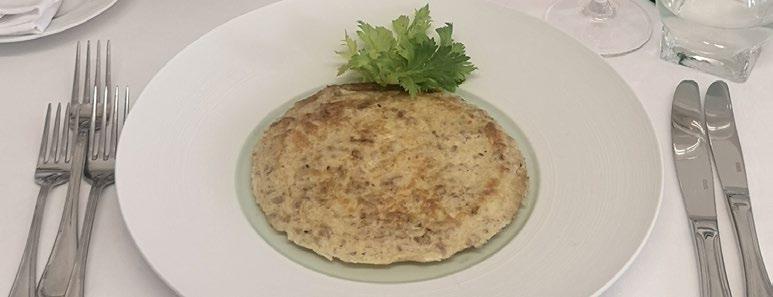
APPETIZER
Frità rugnusa
Omelette with salami preserved in lard
Recipe for 4 persons
Ingredients
• 8 eggs
• 250 g salam ‘d l’ula (salami preserved in lard)
• 50 g Grana cheese
• 50 g butter
• Fine salt
Preparation
Remove the casing from the salami and crumble it. Brown in a pan and let cool. Whisk the eggs with a pinch of salt and the grated Grana cheese, then stir in the cooled salami. Melt the butter in a frying pan, pour in the egg mixture, and cook over low heat. Flip the omelette and finish cooking. Arrange on a plate and serve hot.
Biella
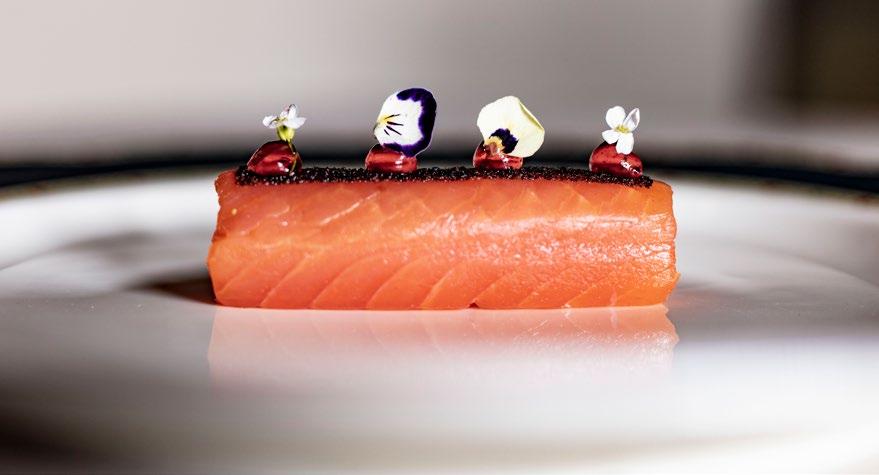
Lingotto del Mergozzo
Bar-shaped smoked trout in the Lake Mergozzo-style
Recipe for 4 persons APPETIZER Lakes
Ingredients
• 340 g lake trout
• 8 g raspberry gelatine
• 50 g black vinegar bread
• Wildflowers
For the smoked trout:
• 300 g trout a baffa (cold smoked trout fillet)
• 10 g sugar
• 38 g integral salt
For the raspberry gelatine:
• 30 g raspberry vinegar
• 20 g sugar
• 0,5 g agar agar
For the black vinegar bread:
• 10 g bread slices
• 50 g balsamic vinegar
• 1 g activated charcoal
Preparation
For the smoked trout: prepare the trout, add seasoning and let it marinate for 6 hours. Rinse off the excess salt, dry and smoke with cypress needles. Let the fish set in the refrigerator for a day before removing the bones and cleaning. Make 4 lingotti (bar-shaped portions), 70 g each, from the baffa smoked trout. Use a piece of plastic wrap to give each piece a cylindrical shape and let them set for another day in the refrigerator.
For the raspberry gelatine: make the raspberry gelatine by combining the ingredients and bringing the mixture to a boil. Spread the mixture in a pan and break it up with a whisk.
For the black vinegar bread: eliminate the bread crust. Dissolve the charcoal in the vinegar and let the bread absorb the liquid. Dehydrate overnight. Put in the blender and mince into large crumbs.
Garnish and presentation: place the cylinder shaped lingotto in the centre of the plate. Make a line of black breadcrumbs and raspberry gelatine on top of the lingotto. Garnish with fresh flowers.
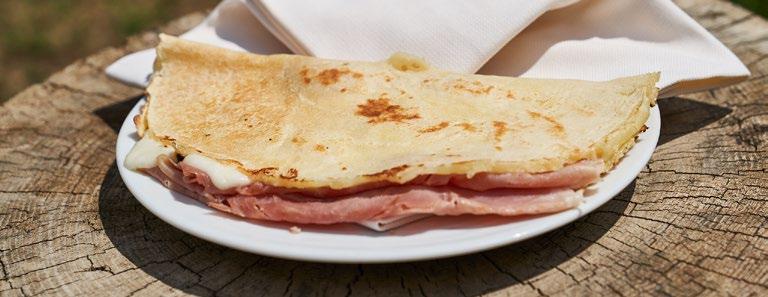
Miacce APPETIZER
Recipe for 6 persons
Ingredients
• 300 g white flour
• 1 l whole milk
• 100 g fresh cream
• Salt
Preparation
Whip the cream until stiff, add the flour and milk mixing until the batter is fairly consistent but still liquid. Pour a ladleful of the batter onto one side of the necessarily preheated miaccia irons (greased with lard), then hold the iron over the flame. Cook the miacce on both sides. Serve filled with cold cuts, Toma cheese, melted butter, or jam.
Valsesia
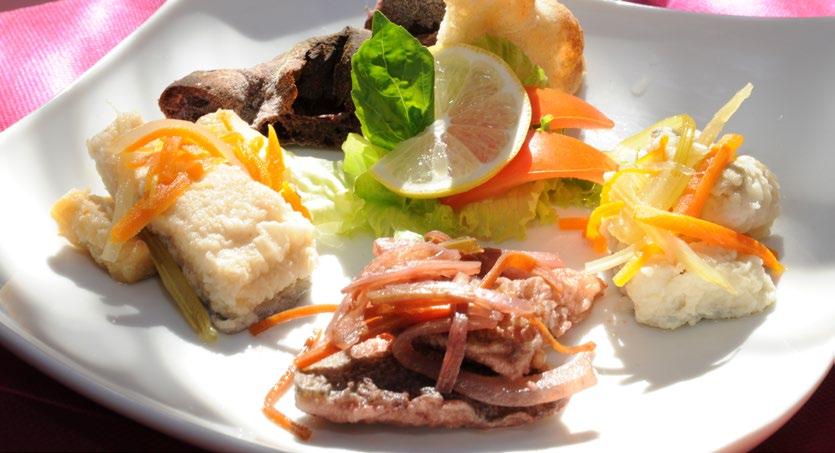
Recipe for 4 persons
Ingredients
For the red carpione marinade:
• 160 g white fish fillets
• 120 g red wine vinegar
• 240 g red wine
• 240 g water
• 6 g salt
• 15 g sugar
• Juniper berries
• ½ bay leaf
• Black peppercorns
For the white carpione marinade:
• 300 g zander (pike-perch)
• 250 g white trout fillets
• 250 g white wine vinegar
• 500 g white wine
• 500 g water
• 60 g sugar
• 12 g salt
• Juniper berries
• 1 bay leaf
• Black peppercorns
For the vegetables:
• 120 g carrot
• 120 g onion
• 120 g celery
For cooking:
• Vegetable oil
• Extra virgin olive oil
• 00 Flour
• Salt
Preparation
For the vegetables: peel and wash the vegetables. Cut into regular 5-cm sticks and sauté in a pan over moderate heat with a tablespoon of extra virgin olive oil. Add salt as desired while cooking.
For the two marinades:
in two different pans, boil the vinegar, wine, water, sugar, salt and herbs. Let simmer for 5 minutes, add the sautéed vegetables (divided equally between the two marinades) and boil for another minute. Remove from the burner and let cool. Cut the fish into regular pieces that can be divided into 4 portions. Lightly coat in flour and fry them in a pan with the vegetable oil, salt and dry with paper towels. It is important that the fish remains crisp. Let cool. Divide the white carpione marinade into two equal parts and pour into two containers and put the zander in one container and the white trout in the other. Put the white fish into the red marinade. The fish must marinate at least 1 day.
Serving: remove the fish and vegetables from the marinade and serve with a green salad and a piece of focaccia bread.
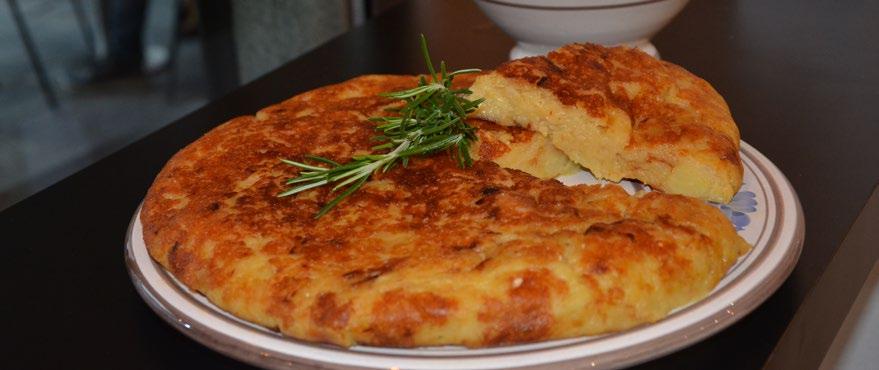
APPETIZER
Prata Hapfla
Potato pancake
Recipe for 6 persons
Ingredients
• 1 kg Roti Oigjè local potatoes
• 300 g Formazza cheese, aged 3 months
• 1 large yellow onion
• 1/2 teaspoon of lard or Formazza butter
Preparation
Boil the potatoes and cut the cheese into cubes. Peel the potatoes after they are done and cut them into chunks. In a non-stick skillet, sauté the onion in the lard or the butter until it is golden in colour. Then add the potatoes, mix well and incorporate the cheese cubes. Turn the mixture over, as if it were an omelette. When it is golden brown on both sides, it is ready to serve.
Ossola Valleys
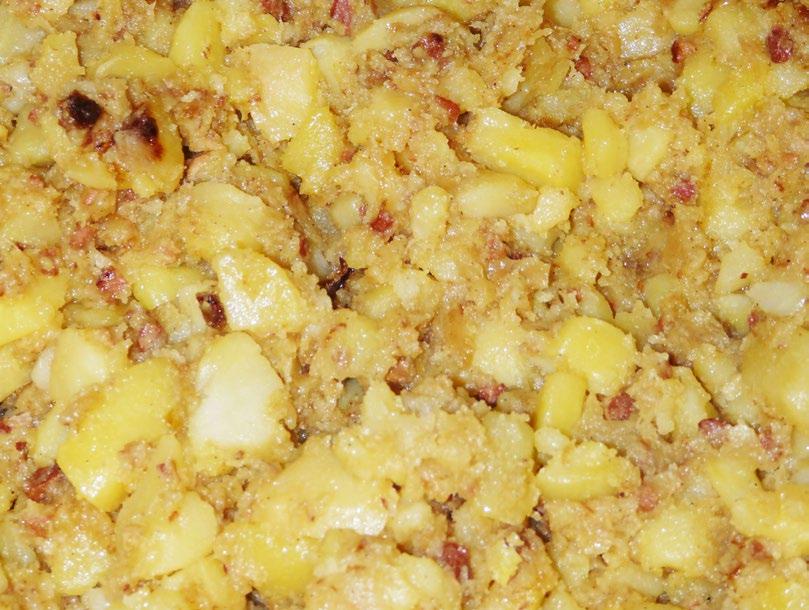
Ingredients
• 750 g red potatoes
• 300 g white onions
• 84 g fresh bacon
• 30 g butter
• 60 g extra virgin olive oil
• Salt and pepper
Preparation
In a large skillet, sauté the bacon slowly in the oil until transparent. Add the onion and braise it slowly while mixing. Add salt and pepper. Add butter when fully cooked. Boil potatoes separately and peel when cooked. Slice and add to the onion sauce prepared previously. Sauté for a few minutes.
Ossola Valleys
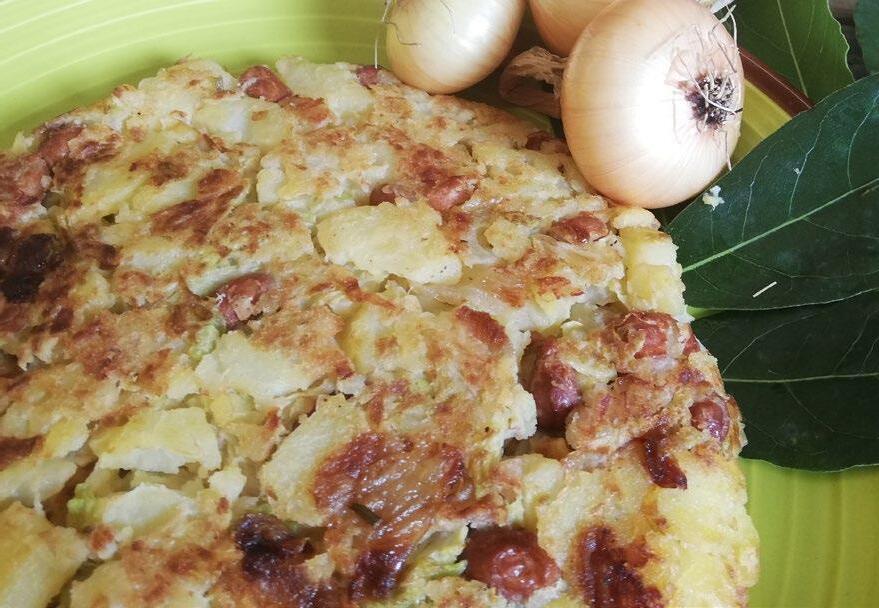
Ingredients
• 1 kg potatoes
• 1,5 kg savoy cabbage
• 200 g beans
• 1 large yellow onion from Cureggio and Fontaneto
• 100 g lard
• 50 g butter
• 30 g extra virgin olive oil
• 1 sprig of rosemary
• 2 bay leaves, to taste
• Salt
Preparation
Separately cook the potatoes and the cabbage. After peeling and slightly mashing the potatoes, add them to the squeezed cabbage and the beans, mixing everything together with a pinch of salt. In a non-stick pan, put the oil, the finely chopped lard, the butter, the minced onion and, once the onion is soft and golden, add the vegetables. Press down with a spatula and let it cook on medium heat for a few minutes on each side until golden brown, seasoning with salt. Serve warm.
Novara
Lakes
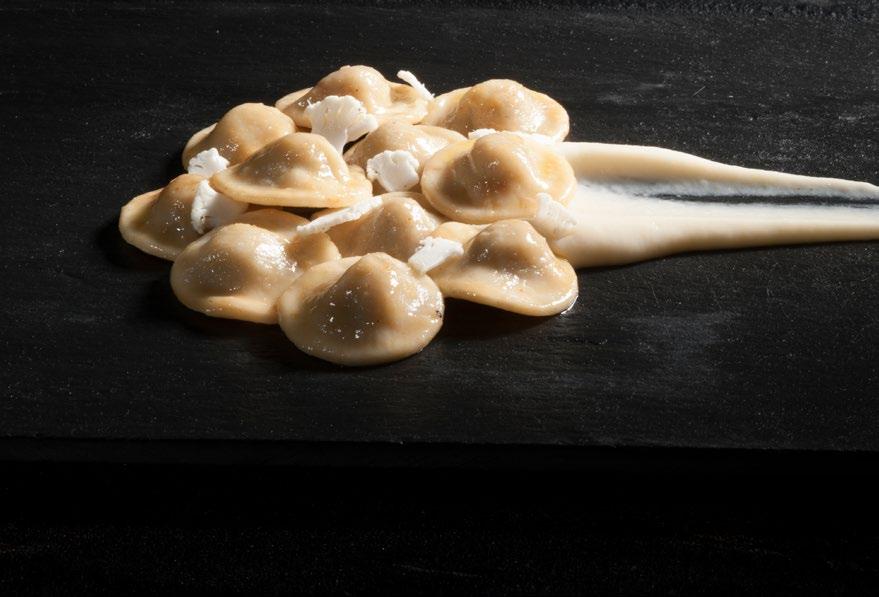
• 200 g lake fish stuffing
• 300 g fresh pasta made with egg white
• 80 g cream of cauliflower
• Reduced broth made from lake fish
• Cooking juices from lake fish
• Shrimp shell dust
• Cauliflower grated with a microplane
• Herbs or flowers
For the lake fish stuffing:
• 60 g burbot
• 60 g white fish fillets
• 60 g trout
• 20 g smoked eel
• 20 g offal and eggs from the various fish
• 40 g butter
• 1 shallot
• 1 white onion
• Salt
For the fresh pasta made with egg white:
• 200 g 00 flour
• 100 g egg whites
For the reduced broth made from lake fish:
• 1 stalk of celery
• 1 carrot
• 1 white onion
• Fish bones and heads
Preparation
For the lake fish stuffing: fillet and remove the spine from the lake fish, sauté the eggs and offal (internal organs) in butter. Sweat the butter on a black Gastronorm pan with pieces of onion and shallot, add the fish cut into chunks, add the offal, salt and cook at 100° for 1 hour. Drain and keep the cooking juices; grind the fish finely with a meat grinder to obtain a homogeneous mixture. Add salt to adjust flavour.
For the fresh pasta made with egg white: mix the ingredients in a planetary mixer until the dough is smooth, just as if you were making normal egg pasta. Let set in a vacuum pack for at least 2 hours and then roll very thin.
For the reduced broth made from lake fish: brown the vegetables in butter, add the fish scraps and bones, and then cover with water and let cook on low heat to extract all the flavours. Filter and reduce.
For the cauliflower cream: sauté the julienned onions in butter until they are soft and then add the cauliflower pieces. Cook very slowly until very soft. Beat, add salt to adjust flavour, and put through a chinois.
Serving:
cook the ravioli in salted water then flavour them in a pan with the fish cooking juices. Use a spoon to distribute the cauliflower cream and the ravioli, use the microplane to grate fresh cauliflower over the dish, pour 1 spoonful of fish broth over the ravioli and lastly, garnish with herbs or flowers. Ingredients
• 2 bay leaves
• 1 clove of garlic
• Enough water to cover
For the cauliflower cream:
• ½ cauliflower
• 40 g butter
• ½ white onion
• Salt
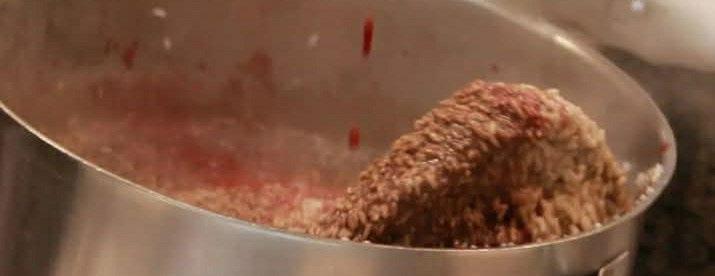
FIRST COURSE
Brudera
Recipe for 4 persons
Ingredients
• 3-4 pork bones
• 400 g Arborio or Carnaroli rice
• 1 onion
• 1 fresh spring onion
• 1 carrot
• 1 celery stalk
• 1 clove of garlic
• 1 sprig of rosemary
• 70 g grated Parmigiano Reggiano cheese
• 2 glasses of full-bodied red wine (e.g. Barbera)
• 50 g butter
• Salt
Preparation
Finely chop the onion and sauté in butter. Add the rice and toast it, then deglaze with the red wine. Prepare a broth by starting with cold water and adding the celery, carrot, onion, and pork bones. Continue cooking the rice using this broth.
Curiosities
Traditionally made in January, or during Carnival, when nothing from the pig was wasted—not even the blood. Brudera is a recipe from the late 19th century which comes from the farmsteads of Vercelli and Southern Piedmont. An easy-to-make risotto, known as alla parmigiana, it is the symbol of a simple and homemade cuisine. Everyone would add a few spices to enhance its flavour, and it was historically finished with pork blood (today strictly pasteurised).
Vercelli
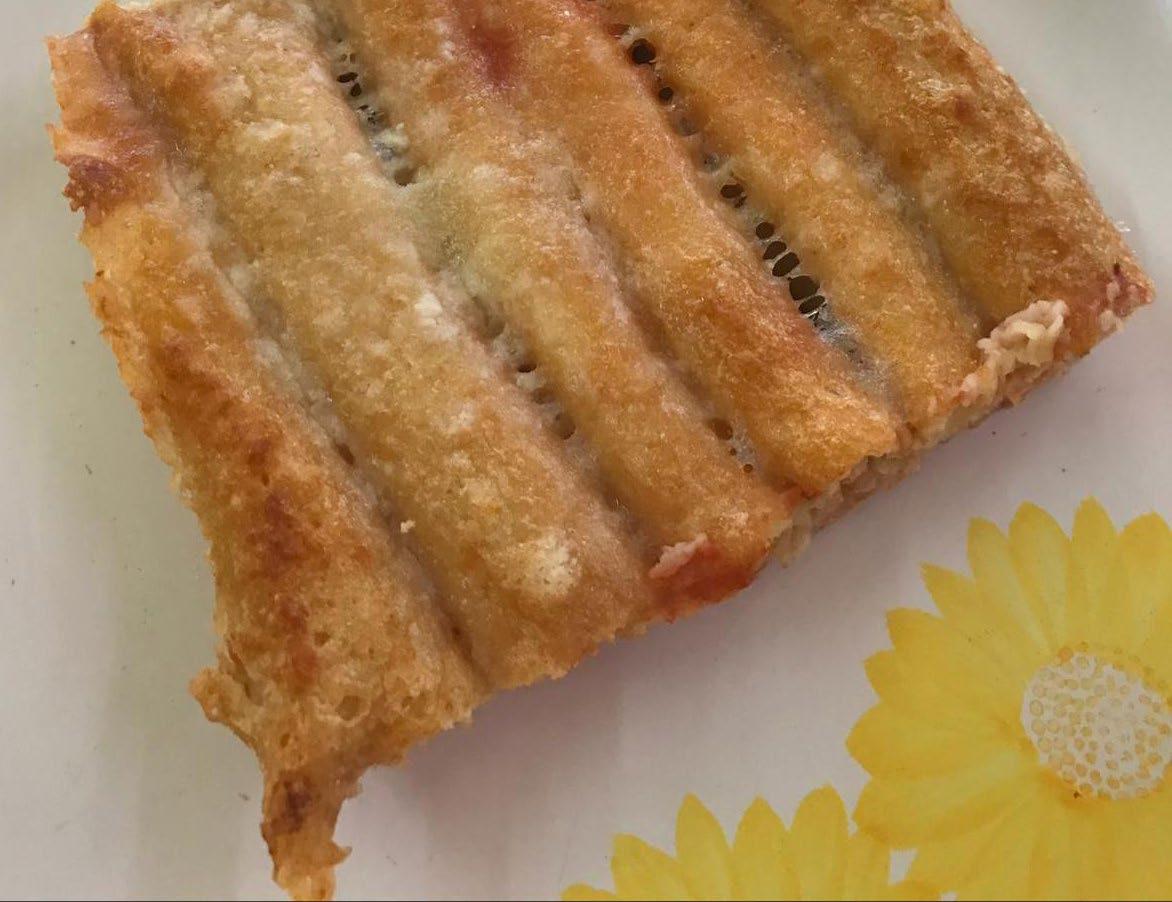
Ingredients
• 2 yellow onions from Cureggio and Fontaneto
• 500 g chopped beef
• 150 g chopped pork
• 150 g veal heart
• 150 g veal sweetbread
• 100 g dry cured ham
• 100 g veal brains
• 200 g chopped tomato
• 500 g boiled spinach
• 3 eggs
• 250 g milk
• 112,5 g 00 flour
• 200 g Parmigiano Reggiano
• 200 g milk
• 200 g cream
• Salt and pepper
Preparation
For the filling:
cut the onions into julienne strips and cook them until soft in a saucepan, add the meats and brown them. Add the tomato and cook for 2 hours adding broth. At the end of the cooking time, add the spinach, previously blanched and squeezed and cook a further 10 minutes to reduce the cooking liquid. Let cool and mince in the meat grinder twice.
For the crêpes: in a bowl, whisk the eggs with the flour and add the milk, salt and pepper. Let the batter rest for about 30 minutes. Blend the mixture in a blender and make some very thin crêpes in the proper pan.
For the Parmigiano Reggiano sauce: in a pot, heat the milk and the cream, add the grated cheese and blend it in a blender.
For the cannelloni:
cut the crêpes in half, spread the meat filling on one side with a piping bag; roll them tightly and cut them into two parts, then place on a greased baking tray. Sprinkle the Parmigiano and pour the melted butter. Cook in a 180° C over for 5 minutes until the cannelloni are golden; serve with the Parmesan sauce.
Novara
Lakes

Ingredients
• 170 g conchiglioni pasta
• 140 g potatoes
• 40 g pink trout fillets
• 40 g white trout fillets
• 40 g white fish fillets
• 20 g zander fillets
• 20 g roach fish fillets
• 20 g tench fillets
• 20 g eel fillets
• 20 g tomato sauce
• 100 ml fish broth
• 30 g onion
• 30 g carrot
• 10 g stalk of celery
• 30 ml white wine
• Marjoram, dill, chives
• Olive oil as needed
For the potato cream:
• 80 g boiled potatoes
• 70 g cream
• 1 teaspoon of butter
• Salt
Preparation
For the stuffed conchiglioni: grind all fish fillets in the meat grinder (without skins). Chop the vegetables and sauté them all together with a drop of olive oil. Add the ground fish, sauté it until golden and douse with white wine. Let the liquid evaporate, add the tomato sauce and continue to cook. If necessary, add a little fish broth. When the sauce is done, add the chopped herbs and let cool. Cook the conchiglioni in plenty of salted water, cool them and fill them with the fish ragu, that has also been cooled.
For the potato cream: cook the potatoes in the skins. Mash them in a potato ricer. Put the potatoes in a bowl and add the cream, salt and melted butter. Beat with a mixer until the mixture is smooth and creamy. Its temperature should be 60/70°C. Pour the mixture into a siphon, close properly, add 1 or 2 gas cartridges and keep warm in a bain marie (60-70°C).
Serving:
heat the conchiglioni in the oven at 110°C with 60% humidity for 5-6 minutes. Arrange them in a flower shape on the plate and put the potato cream in the centre with the siphon. Serve lightly drizzled with oil.
Spoon-shaped gnocchi
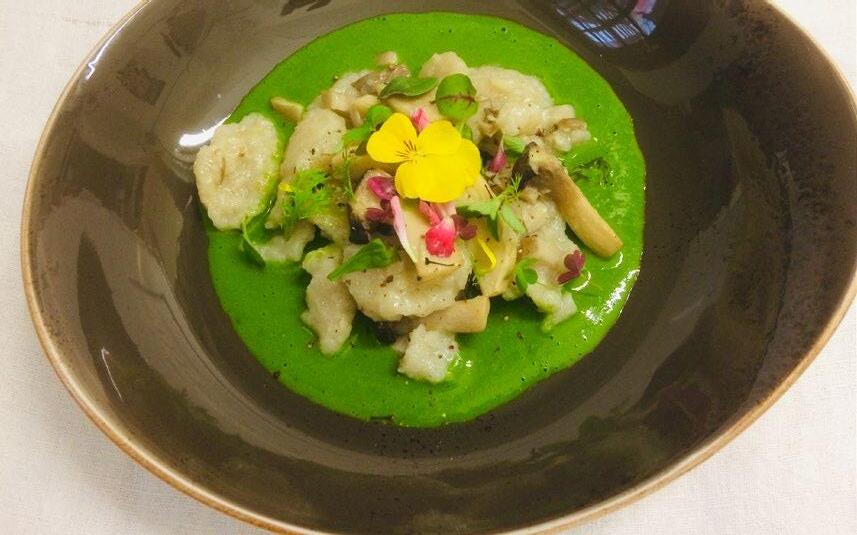
Ingredients
• 500 g 00 flour
• 400 g water
• 4 porcini mushrooms
• Parsley, to taste
• Butter, to taste
• Garlic, to taste
• Salt, to taste
• Aged local cheese, to taste
• Herbs and fresh flowers to decorate
Preparation
For the gnocchi: mix the water and flour vigorously and let rest for a few hours. Use a spoon to form the gnocchi and immediately cook them in boiling water.
For the parsley bed: quickly blanch the parsley and cool it immediately in ice; blend it with butter until it forms a smooth mixture.
For the mushrooms: clean them carefully, slice them and quickly sear them with salt, pepper and garlic. Add the gnocchi.
Serving: put a little parsley sauce on the bottom of the dish, place the gnocchi in the centre, grate the cheese over them and decorate with herbs and flowers.
Ossola Valleys
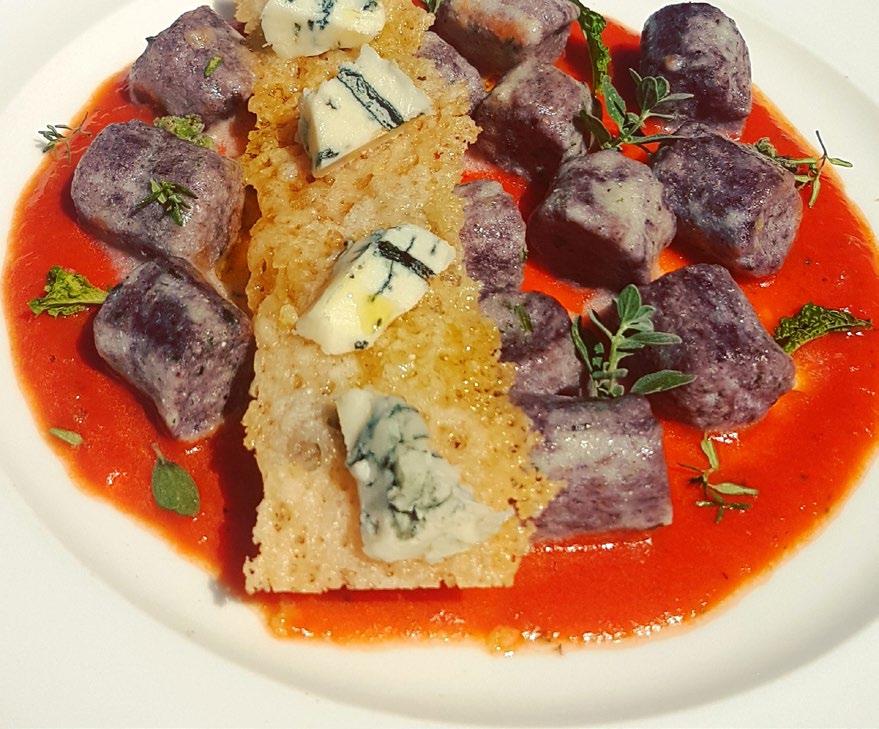
Ingredients
• 100 g Artemide black rice
• 500 g Ricotta cheese
• 500 g cherry tomatoes
• 200 g of Gorgonzola Piccante (spicy)
• 150 g flour
• 2 egg yolks
• Parmigiano to taste
• Extra virgin olive oil to taste
• Salt
• Pepper
Preparation
For the gnocchi: boil the Artemide rice for at least 50 minutes, blend it and make a paste of it. Create a dough by mixing the Ricotta, the flour, the rice paste, an egg and some Parmigiano. Mix everything, roll out the dough with your fingertips to create strips of about 2 cm, which you then cut into chunks. Boil the gnocchi in lightly salted water, toss them in butter and set aside.
For the tomato sauce: cook the fresh cherry tomatoes for just a minute in olive oil, then put them through a vegetable mill and blend them.
For the wafer: put a slice of Parmigiano in a non-stick pan and melt it until it is slightly golden. Let it cool and mould it into a waffle.
Serving: spread some tomato sauce on the bottom of the bowl, place some gnocchi and complete with the Parmigiano waffle and Gorgonzola Piccante.
Novara
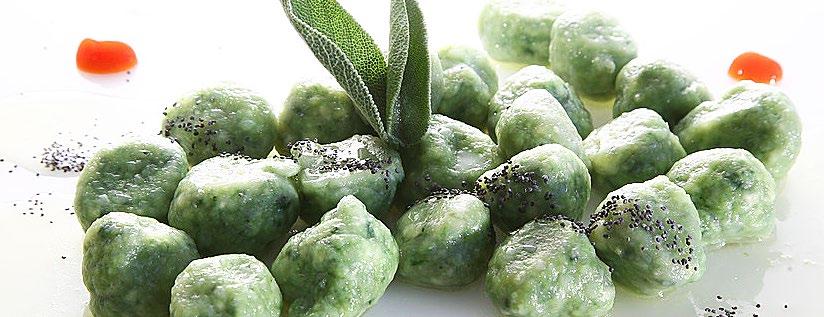
FIRST COURSE
Gnocchetti made with Ricotta from Viceno
Recipe for 6 persons
Ingredients
• 400 g Ricotta cheese from Viceno
• 150 g boiled spinach (or “brucoi” greens)
• 1 egg
• 6 tablespoons of white flour
• Salt, pepper and nutmeg
• Butter and sage
Preparation
Put the Ricotta in a mixing bowl. Squeeze and chop the cooked spinach add it to the Ricotta along with the egg. Add the salt, pepper and nutmeg. Mix with a wooden spoon as you add the flour 1 tablespoon at a time. Form the gnocchi with a teaspoon. Boil the gnocchi in salted water; flavour them with plenty of melted butter and sage. Serve hot.
Ossola Valleys
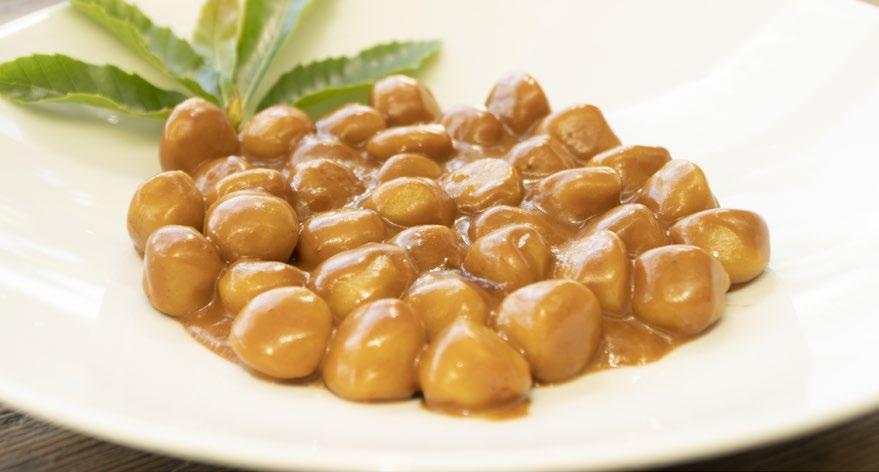
Recipe for 6 persons
Ingredients
• 500 g white flour
• 500 g “granito” flour
• 800 g sweet pumpkin
• 600 g red potatoes
• 100 g chestnuts
• 200 g breadcrumbs
• 2 egg yolks
• 1 teaspoon of extra virgin olive oil
• Salt, pepper and nutmeg
Preparation
Boil the potatoes and the chestnuts, bake the pumpkin in the oven with a little oil and then run these ingredients through a fine sieve. Place a mound of flour on a board; add potatoes, pumpkin, chestnuts, eggs, salt, pepper, nutmeg and oil. Mix and knead and then add the breadcrumbs. Shape the gnocchi as preferred, place them in a pot with boiling water and remove them from the water when they float to the top. At this point, place them in a pan with melted butter and sage, add cooking juices from a roast and typical Toma cheese from the Ossola mountain region. Cook until a creamy sauce forms.
Ossola Valleys
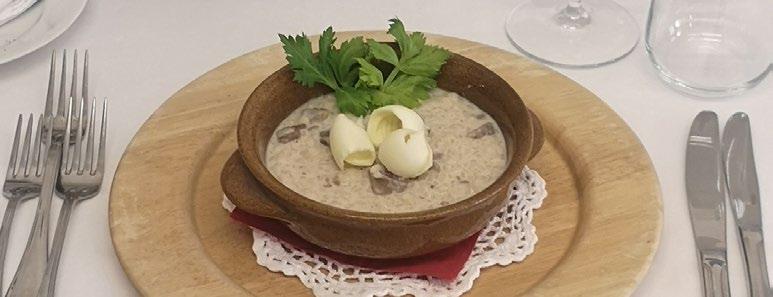
FIRST COURSE
Machtëbbe
Rice, milk and chestnut soup
Recipe for 4 persons
Ingredients
• 900 ml water
• 300 ml milk
• 250 g dried chestnuts
• 200 g Arborio rice
• 100 g butter
• Fine salt
Preparation
Bring the water and milk to a boil in a saucepan. Add the chestnuts and cook over medium heat for 30 minutes. Stir in the rice, season with salt, and cook for another 18 minutes, stirring frequently. If the liquid reduces too much, add a little milk to finish. Let cool and serve with curls of raw butter on top.
Biella
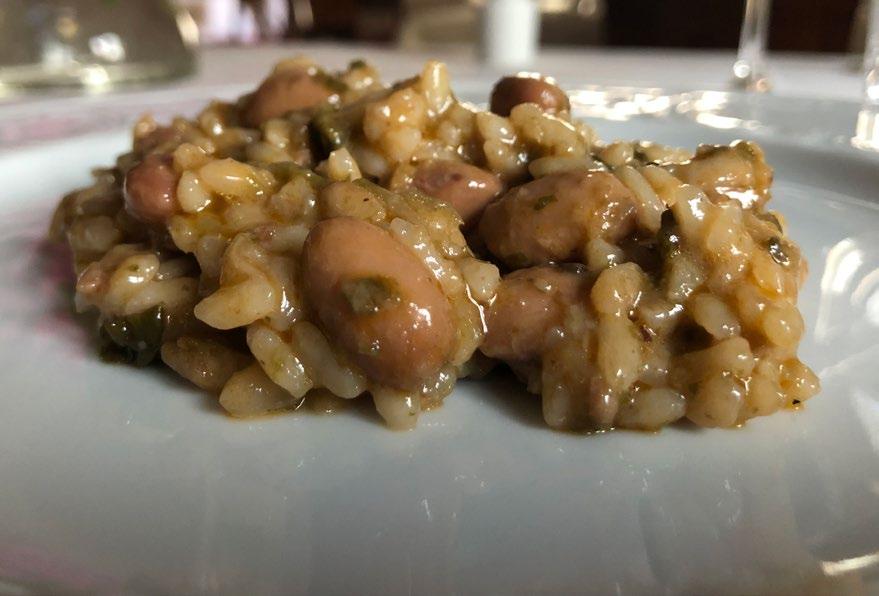
Ingredients
• 350 g Carnaroli rice
• 1 duja salami and 1 “fidighin” (liver mortadella)
• 100 g pork rind
• 50 g lard
• 1 glass of Colline Novaresi red wine
• 30 g butter
• 1 yellow onion from Cureggio and Fontaneto
• 1 celery stick
• 1 carrot
• 2 leeks
• ½ white cabbage
• 250 g shelled fresh borlotti beans or previously soaked dry beans, soak for at least 12 hours
• Vegetables or meat broth
• 2 tomatoes, peeled and seeds removed
• Salt and freshly ground black pepper
Preparation
In a pot, blanch the pork rind and then let it cool, cut it into cubes. In another pot, place the vegetables cut up, add the beans and 2 l of cold water and cook for about 45 minutes. Pound the lard and the finely minced onion, put them into a shallow pot and brown them; when the onion is very soft, add the crumbled “duja” salami and the liver mortadella, brown for a couple of minutes and add the rice. When you have finished toasting the rice, add the pork rinds and the wine and reduce, add the vegetable broth like for a risotto. 10 minutes before the end of the cooking time add the already cooked beans and the tomatoes. Lastly, let it rest away from the heat for some minutes, check for salt and before serving, sprinkle black pepper over the dish. According to the rice plain tradition, the paniscia should be served without any Parmigiano.
Novara
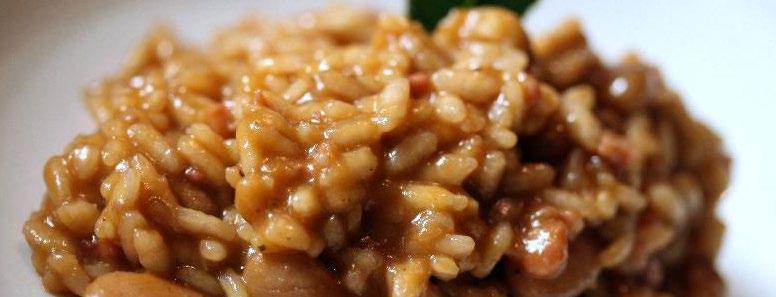
FIRST COURSE
Panissa
Recipe for 4 persons
Ingredients
• 400 g Vialone Nano rice (Baldo or Rosa Marchetti)
• 100 g borlotti beans
• 1 onion
• 100 g lard
• 1 salam d’la duja (Piedmontese soft salami)
• 1 glass of full-bodied red wine (e.g. Barbera)
• Vegetable broth as needed
• Salt and pepper
Preparation
Cook the rice in a broth made with borlotti beans (from Villata or Saluggia). Prepare a sauté with onion, salam d’la duja, and lard, then add to the rice and deglaze with wine.
Traditionally, some cooks enrich the broth with “previ” pork rind seasoned with spices and bay leaves.
Serve with a sprinkle of black pepper and, for traditionalists, a dash of red wine. Cook in copper if possible.
From the rice field to the plate, through the vineyard and the barn: all ingredients are easy to find, but worthy of a day of celebration. It’s said that changing courtyards in Vercelli yields a different take on this iconic dish.
Vercelli
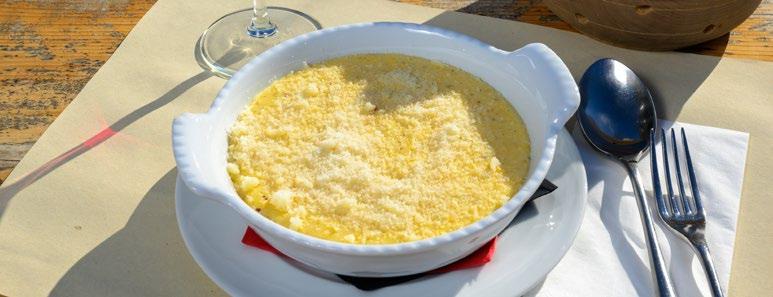
FIRST COURSE
Polenta Concia
Recipe for 4 persons
Ingredients
• 350 g corn flour
• 200 g Toma cheese
• 1 l milk
• 100 g Fontina or Maccagno cheese
• 1,5 l water
• 100 g butter
• Salt
Preparation
In a copper pot, boil the water and milk with a handful of flour. Add salt, then gradually stir in the remaining flour vigorously to prevent lumps. Continue for about 50 minutes. Slice the cheese. Melt and lightly brown the butter in a separate pan. When the polenta is nearly done, add the cheese and stir until melted. Serve on hot plates, topped with melted butter to taste.
Curiosities
The polenta concia is a typical dish of Valsesia and Biella areas; in Biella and its surroundings a Festival celebrates it in early November.
Valsesia
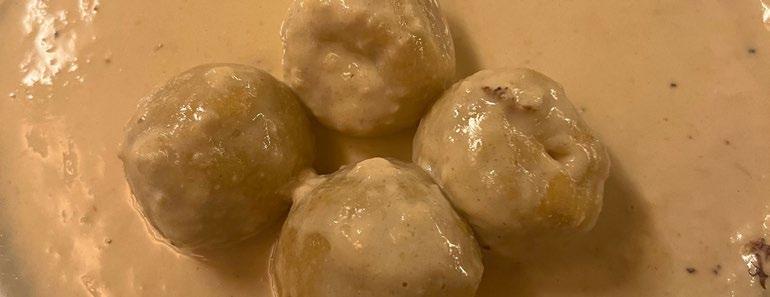
FIRST COURSE
Ràviole
Recipe for 10 persons
Ingredients
• 500 g corn flour
• 100 g 00 soft wheat flour
• 30 g butter
• 2 l milk
• 100 g Toma cheese
• 100 g salam d’la duja (salami preserved in lard)
• 200 g smoked bacon
• 100 g bread
• 2 eggs
Preparation
Bring the milk and salted water to a boil. In a steel bowl, soften the bread with 2 l of milk. Add the eggs, then incorporate both flours and knead until the dough is smooth and homogeneous. It should not be too firm, as it may fall apart during cooking—if needed, add a little more milk to adjust the consistency. Form small balls of dough and fill them with Toma cheese, salami, or butter. Once the milk and water are boiling, add the smoked bacon, previously diced. Gently immerse the ràviole one at a time, taking care to prevent them from sticking to the bottom. Cook over low heat for about 1 hour. Do not stir once they begin boiling again, as the ràviole are delicate and may disintegrate.
Valsesia
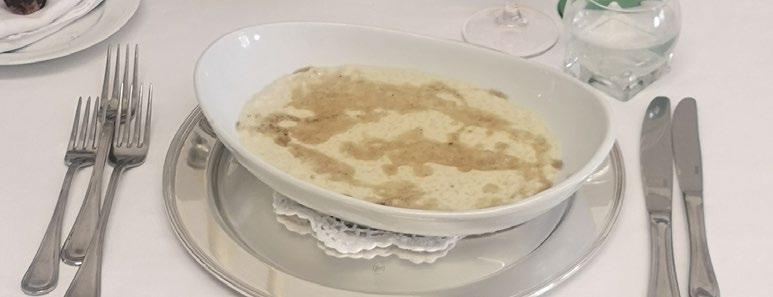
FIRST COURSE
Ris an Cagnon
Risotto with Maccagno cheese and brown butter
Recipe for 4 persons
Ingredients
• 320 g Arborio rice
• 250 g Maccagno cheese
• 80 g butter
• 900 ml meat broth
• 200 ml milk
• 20 ml extra virgin olive oil
• Fine salt
Preparation
Heat oil in a pan, add the rice and toast it lightly. Add broth and bring to a boil. Pour in the milk, reduce heat and cook for 18 minutes, stirring frequently. Remove the rind from the Maccagno cheese and cut it into cubes. Stir into the risotto off the heat, then add the salt. Melt the butter in a small pan until golden and nutty. Drizzle over plated risotto and serve immediately.
Biella
Lakes
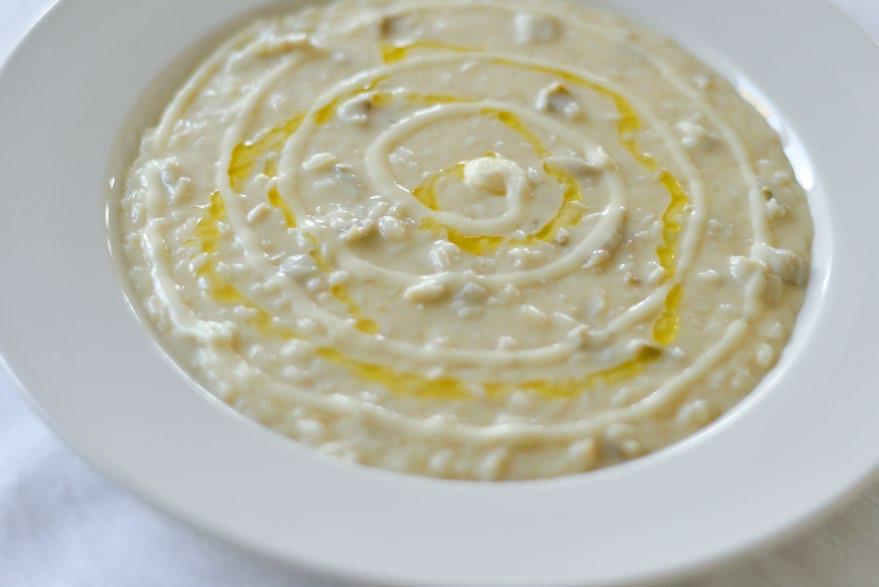
Ingredients
• 280 g Carnaroli rice
• 150 g perch fillet, flattened
• 100 g mountain pasture butter
• 100 g Parmigiano Reggiano cheese, aged 36 months
• 50 g shallots
• Stock made from lake fish, to taste
• Prosecco wine
• Rock salt
• Extra virgin olive oil, to taste
• 200 g fresh cream
• Lemon zest
Preparation
For the risotto: toast the rice with a small quantity of extra virgin olive oil and 4 pinches of rock salt. After it is warm, add the shallot and the Prosecco and let the wine evaporate. Then, add the perch fillets and cover with the fish stock. Cook 12 minutes. Remove from burner, add the butter and Parmigiano Reggiano cheese and cover. Let set for 1 minute. Blend and adjust flavour with salt and pepper.
For the lemon cream: bring the cream to a boil. Remove from burner and add the rind of 1 organic lemon for 15 minutes. Let cool.
Serving: garnish the risotto dish with a spiral of lemon cream.
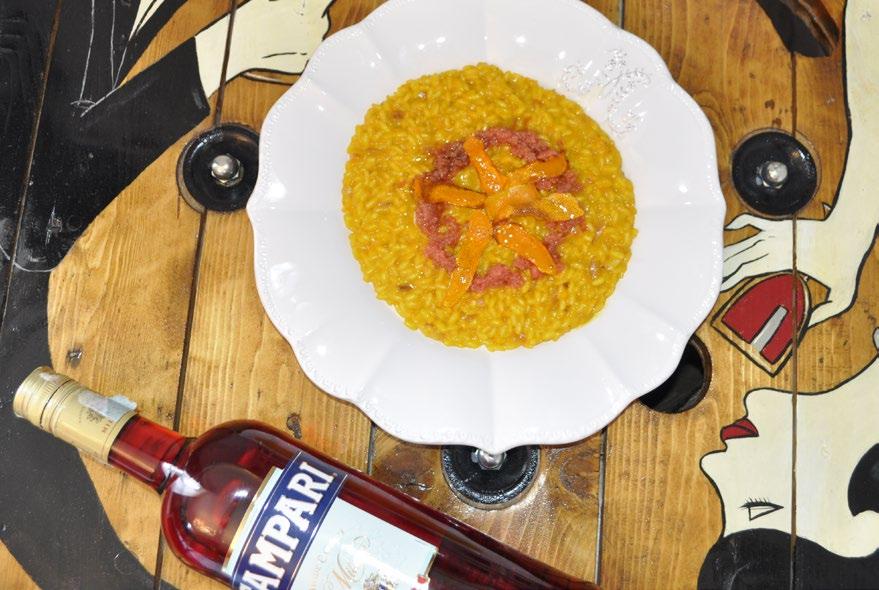
Ingredients
• 160 g Razza77 rice
• 30 g yellow onion from Cureggio and Fontaneto
• 30 g onions
• Extra virgin olive oil
• Butter
• 1 orange (zest and juice)
• 1 glass of Campari
• Vegetable broth
• Saffron
• Sugar
• Parmigiano Reggiano cheese
Preparation
In a low and non-stick pan, pour the Campari and the sugar and cook for 5 minutes on medium heat to make a caramel. Sauté the onions with a little oil; when they are golden brown, add the Razza77 rice and toast it for about 3 minutes. At this point, wet the rice with a little Campari and start to gradually add a ladleful of vegetable broth. Halfway through, add the saffron, some orange juice and the grated orange zest. Continue to add the broth and continue to mix until cooked. Once the cooking is done, pour the risotto into a baking dish and stir in the Parmigiano and the butter. Once served into plates, you can add some caramelized orange zests.
Razza77 rice allows you to stir the risotto with no butter if preferred, thanks to its high level of starch that is released during the cooking process, which allows you to achieve a great “wave” without adding butter.
A bit of history
The Razza77 rice variety dates back to the Thirties and was appreciated for its culinary qualities in the preparation of traditional risottos, to the point of being mentioned in many old recipe books. From the Sixties onwards, however, its cultivation stopped, due to its predisposition to being attacked by fungal diseases and how quickly it would wilt (when mature, the plant would wilt to the ground due to how heavy the panicle would get, making the harvesting very difficult).
These issues did not dissuade a few headstrong farmers and entrepreneurs from Novara, who were adamant that they would start growing it again, in the perspective of recovering a historical rice variety and a broader promotion of the rice growing and farming culture.
In 1860 finally Gaspare Campari invented the famous red aperitif in the rooms of Caffè dell’Amicizia, which once stood in the historic centre of Novara, place now remembered by a commemorative plaque.
Novara
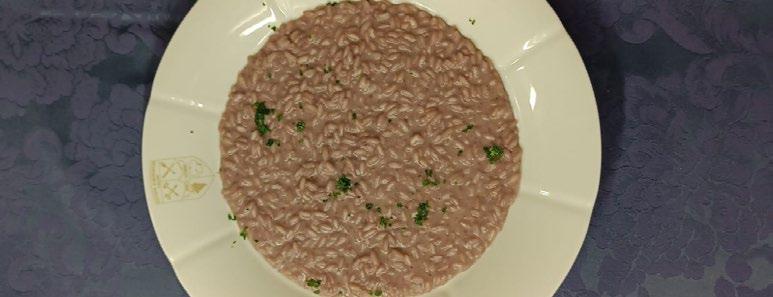
FIRST COURSE
Risotto with Gattinara wine
Recipe for 4 persons
Ingredients
• 320 g Sant’Andrea rice
• 60 g butter
• 2 tablespoons of extra virgin olive oil, as needed
• Vegetable broth, as needed
• 4 glasses Gattinara wine DOCG
• 1 red onion
• 1 tablespoon of tomato paste
• 1 bay leaf
• Grated Parmigiano Reggiano cheese
• Salt and pepper
Preparation
Prepare hot vegetable broth with carrot, onion, and celery. Sauté chopped red onion with butter, oil, and bay leaf until softened. Add the rice and toast it on a medium flame for three minutes, add the wine and make sure it evaporates, even if not completely (by ‘smelling’ the rice, in fact, you should still slightly taste the alcohol). Allow some alcohol to remain for aroma. Add broth gradually while stirring using a wooden spoon. Mix in the tomato paste. After about 17 minutes, season with salt and pepper to taste. Finish cooking off flame with a knob of butter and Parmigiano Reggiano cheese, wait a minute and serve.
Valsesia
Ingredients
• 2 l vegetable broth
• 420 g Carnaroli rice
• 150 ml white wine
• 1 yellow onion from Cureggio and Fontaneto
• 160 g butter to toast the rice
• 180 g Mascarpone cheese
• Salt to taste
• 70 g walnuts
• 200 g spicy Gorgonzola
• 250 g sweet Gorgonzola
• Seed oil
• 160 g milk
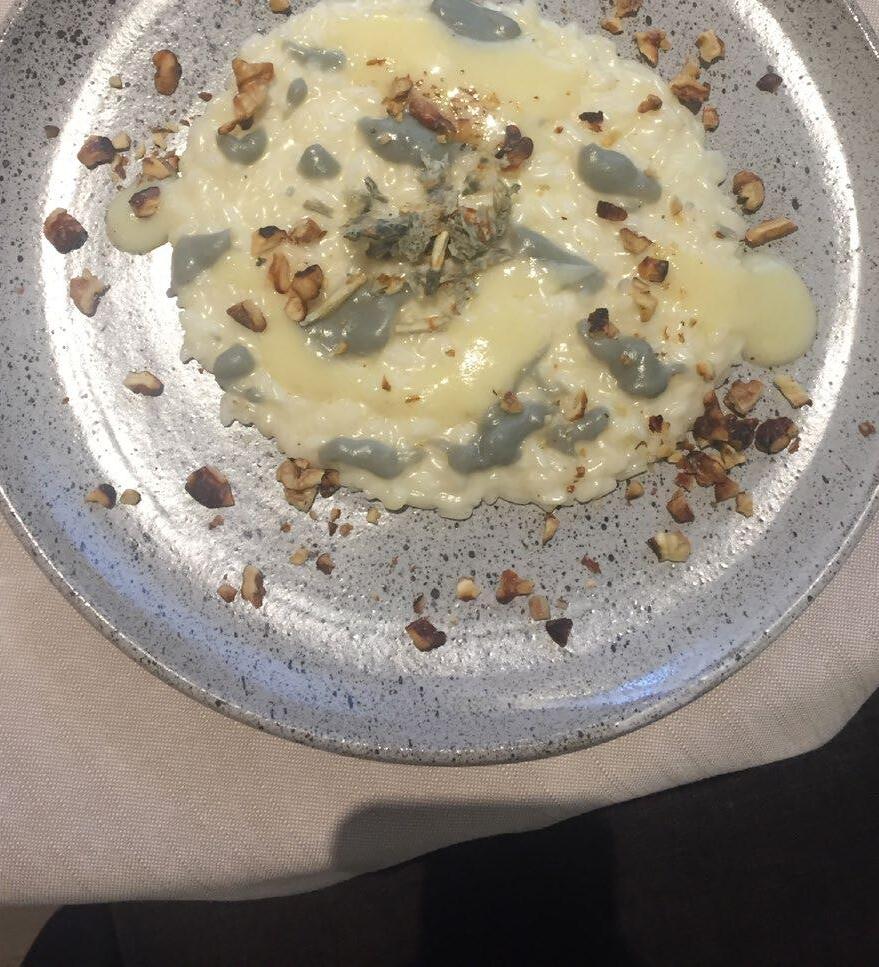
Preparation
For the walnuts: in a pan add some oil, heat it up well and sauté the walnuts for a few minutes until they are a darker golden brown, remove from the pan and roughly chop.
For the sauce: melt both varieties of Gorgonzola in 80 g of warm milk each, and blend to obtain a soft sauce. Keep both warm.
For the risotto:
heat up 60 g of butter, add the sliced onion and cook it for a few minutes and then add the rice. Toast the rice, wet it with white wine, remove the onion and cook with the broth, seasoning with salt. Once cooked, remove from heat and stir in the Mascarpone and remaining 100 g of butter. Plate and decorate to taste with the two Gorgonzola sauces and the walnuts.
Novara

Ingredients
• 1/2 yellow onion
• 400 g Superfino Carnaroli rice
• 4 scallops of foie gras (about 200 g total)
• 1,2 l meat broth
• 0,5 l Prünent red wine
• Local butter, to taste
• Parmigiano Reggiano cheese to taste
• Salt
• Flour as needed
Preparation
For the risotto: sauté the onion with a knob of butter and toast the rice. Pour 3/4 of the wine over the rice and let evaporate. Add the broth gradually and cook for about 18 minutes.
For the wine sauce: in the meantime, reduce the remaining Prünent by 2/3 and make it creamy with the butter kneaded with a bit of flour.
For the foie gras: in another pan, melt a little butter, lightly flour the foie gras scallops and fry until golden on both sides.
Serving: when the rice is done, add a handful of grated Parmigiano Reggiano cheese and a tablespoon of butter. Put into the serving bowls. Decorate with a spoonful of the reduction, over and around the rice. Set the warm scallop on top and enjoy your risotto with a nice glass of Prünent.
Ossola Valleys
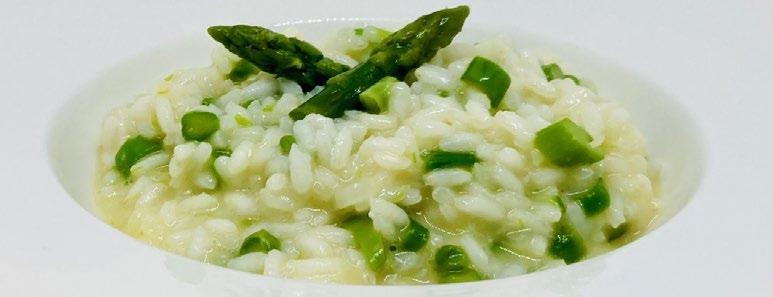
FIRST COURSE
Risotto with Borgo d’Ale asparagus and Toma cheese
Recipe for 4 persons
Ingredients
• 1 bunch of asparagus
• 9 handfuls rice
• 1 onion
• 80 g Toma cheese
• ½ l vegetable broth
• Parmigiano Reggiano cheese, to taste
• ½ glass dry white wine
• ½ tablespoon of extra virgin olive oil
• Salt
Preparation
Clean asparagus and trim off the woody ends. Use trimmings to flavour the vegetable broth (celery, carrot, onion, and some flavour of your choice). Keep the tips to add at the end for a fresh, crunchy note (they should be added just before the rice is stir-fried, so as not to spoil the texture and appearance).Cut the remaining portion of the stalks into round slices and sauté the asparagus with onion or shallot. Toast the rice (Arborio or Carnaroli), deglaze with wine, and cook with the broth. When done, add the diced Toma and reserved tips. Stir in cold butter and Parmigiano Reggiano cheese before serving.
A celebration of spring, this risotto balances the delicate notes of asparagus with the bold character of Toma cheese.
Vercelli
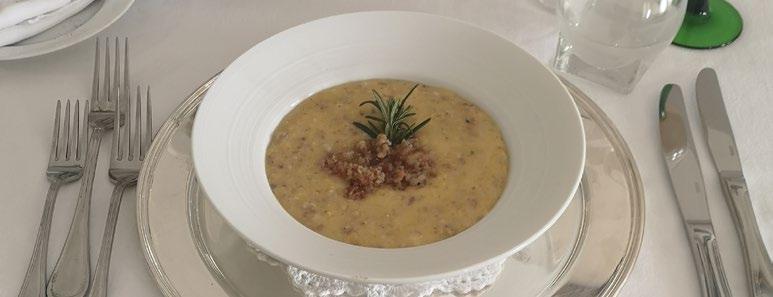
FIRST COURSE
Soët an Pèure
Soft polenta with Maccagno cheese and sausage
Recipe for 4 persons
Ingredients
• 400 gr Maccagno cheese
• 250 g sausage
• 150 g butter
• 130 g whole cornmeal
• 1 sprig of rosemary
• Fine salt and black pepper
Preparation
Boil 1 l of water with salt. Stir in the maize flour and cook over low heat for 1 hour. Remove the rind from the Maccagno cheese and cut it into cubes. In a separate pan, melt 50 g butter and brown the sausage with rosemary. When the polenta is ready, stir in the cheese until melted. Add sausage and its seasoning (without rosemary). Brown the remaining 100 g butter until nutty and pour over. Finish with black pepper and serve hot.
A bit of history
A dish from Fiano in Occhieppo Superiore, Soët is made during the Feast of St. Anthony Abate, held on the Sunday closest to 17th January. It’s a local variant of polenta concia, typical of the Oropa basin and the entire Biellese region, enhanced with sausage.
Biella
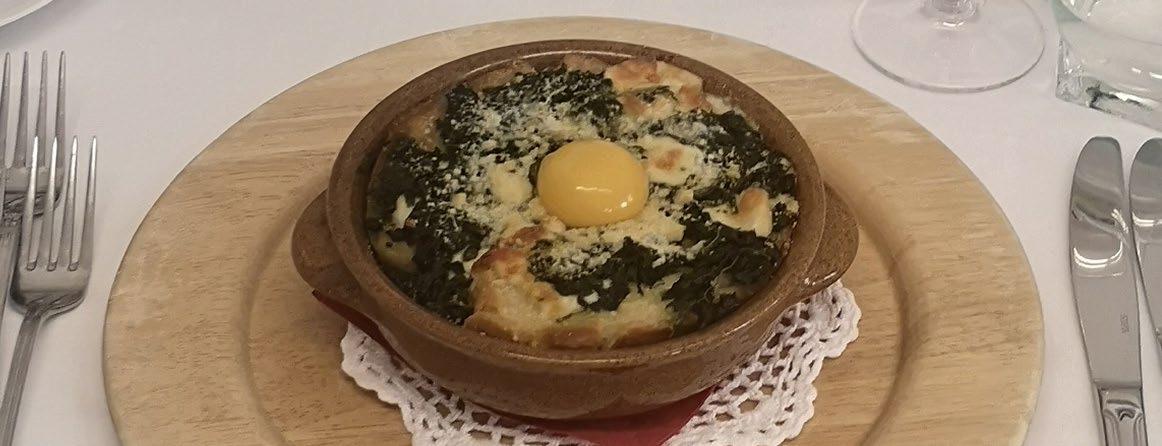
FIRST COURSE
Supa Mitonà
Gratinated bread soup with Maccagno cheese and wild herbs
Recipe for 4 persons
Ingredients
• 400 g stale white bread
• 250 g Maccagno cheese
• 200 g wild herbs (or chard)
• 600 ml meat broth
• 100 g butter
• 80 g Grana cheese
• 4 egg yolks
• Fine salt
Preparation
Slice the bread into ½ cm slices and brown them in a pan with 50 g of butter. Set aside. Clean and wash the herbs thoroughly, then stew them with the remaining 50 g of butter and a pinch of salt. Remove the rind from the Maccagno cheese and cut it into thin slices. In a baking dish (or four single-serving dishes), layer the bread, Maccagno cheese, and stewed herbs. Gradually pour in the broth, allowing it to soak in well. Let rest for 15–20 minutes. Sprinkle with grated Grana cheese and bake at 180°C for about 15 minutes, or until golden and gratinated. Remove from the oven, top each portion with an egg yolk, and serve piping hot.
Biella
Lakes
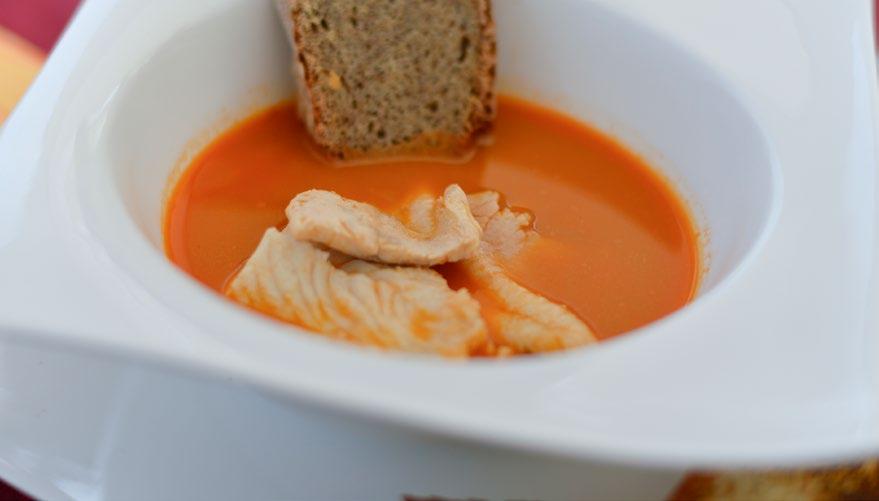
Ingredients
For the mirepoix:
• 1 carrot
• 1 onion
• 1 celery stalk
For the soup:
• 500 g lake fish fillets (white fish, roach and trout)
• Lake fish scraps
• Enough water to cover
• White wine to taste
• Salt and pepper
• Thyme and marjoram
Preparation
Start by sautéing the mirepoix (carrot, onion and celery). Add the fish scraps (heads/bones) and garlic and then douse with white wine and evaporate. Add water as needed and adjust flavour with salt and pepper. Add thyme and marjoram and boil the soup for about 70 minutes. Filter to obtain fish broth. Cut the white fish, roach and trout fillets into strips and boil them in the fish broth for a few minutes (depending on size). Serve in a bowl with grilled bread crostoni.

Ingredients
• 4 pieces of fresh baccalà (salted cod)
• 4 medium-sized Formazza potatoes
• 2 yellow onions
• 1 clove of garlic
• 1 l milk
• Parsley
• Extra virgin olive oil, to taste
• Beet shoots
Preparation
For the potato spheres and the milk and onion cream: boil the potatoes, then peel them and use a melon baller to form spheres that we will boil until done. Douse them with extra virgin olive oil and keep warm. In the meantime, cut the onion into julienne strips and simmer it in the milk slowly to form a cream. Filter the cream and let it cool. After it is cold, load a siphon with the cream and 2 gas cartridges.
For the baccalà: set the pieces of fish on a baking sheet and drizzle with extra virgin olive oil, sprinkle with salt and parsley stalks. Cover with tin foil and bake in the oven at 200°C until the internal temperature of the fish measures 50°C.
Serving:
remove the skin from the piece of baccalà and place it on the plate. Place potato spheres and beet shoots next to it and then garnish with the milk and onion cream.
Ossola Valleys
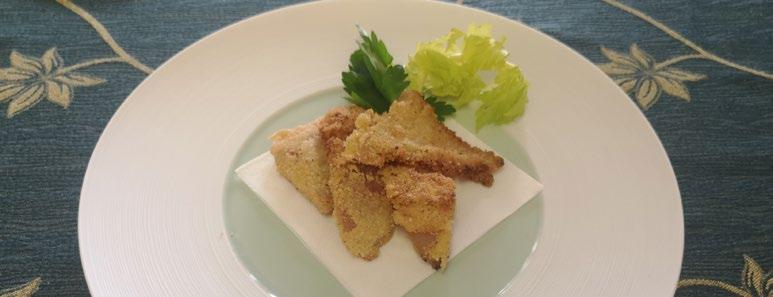
SECOND COURSE
Batsoà Recipe for 4 persons
Crispy pork trotters
Ingredients
• 2 pork trotters
• 1 onion
• 1 carrot
• 1 celery stalk
• 3 bay leaves
• 6 cloves
• 100 ml white vinegar
• 100 g breadcrumbs
• 100 g butter
• 50 g 00 flour
• 1 egg
• Rock salt
• Parsley
• Nutmeg
Preparation
Cut the pork trotters lengthwise and place them in cold water with all the herbs and rock salt. Cook over low heat for 2–3 hours, until tender and falling off the bone. Let them cool in the cooking liquid, then remove all the small bones and dry the meat. In a bowl, whisk the egg with a pinch of fine salt, nutmeg, and chopped parsley. Cut the meat into pieces, dust with flour, dip in the egg mixture, and coat with breadcrumbs. Melt the butter in a pan and fry the pieces until golden brown, drain and serve hot with lemon.
A bit of history
Batsoà is a contraction of “bas-de-soie”, or “silk stockings,” referring to their soft, delicate texture.
Biella
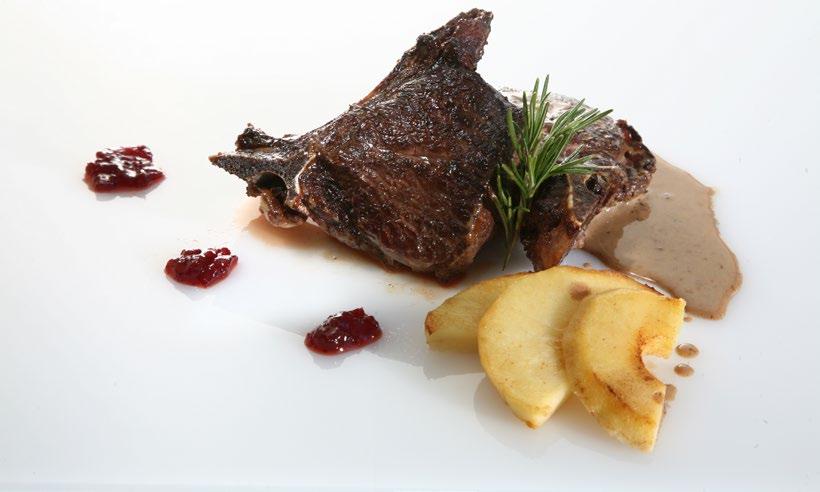
Ingredients
• 4 venison rib-eye steaks from the Ossola Valleys (environmentally friendly production chain)
• 50 g cream
• Butter and oil
• Herbs, garlic, salt and pepper, to taste
• Ca’ d’Matè grappa (mountain liqueur), as needed
• 1 apple
• Red blueberry jam
Preparation
Sauté the venison steak in the butter and herbs in a pan (preferably made of aluminium) over medium heat, then add salt and pepper. After a brief cooking time (the interior of the meat must remain very rare), eliminate the grease from the pan and add the grappa. Let it evaporate with a drop of liquid cream to make a sauce. In a non-stick pan, cook a slice of apple with a drop of oil. Serve the steak covered with plenty of sauce, a cooked apple round and a spoonful of red blueberry jam.
Ossola Valleys
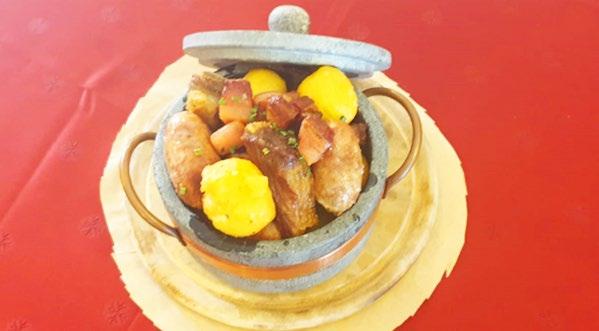
Ribs, salamis, bacon and potatoes
Recipe for 4 persons
Ingredients
• 0,5 kg cooked mountain pasture butter
• 1,5 kg small whole red potatoes from the Ossola Valleys
• 4 small salamis, to be cooked
• 4 pork ribs, cut into pieces
• 0,2 kg local bacon
• Rock salt and ground pepper
Preparation
In a pot (preferably made of soapstone, bronze or copper), melt the butter and sauté the bacon, ribs and salamis for a few minutes until golden brown. Add the whole potatoes, a pinch of salt and as much ground pepper as desired. Cover the pot with a lid and cook over low heat, without stirring, for at least 2 to 2 and a half hours. To make sure the food is cooked evenly without stirring, move the pot quickly clockwise and anticlockwise to simulate turning the ingredients in a pan, so that they actually move without being stirred. After the designated cooking time has passed, check the consistency of the potatoes with a pointed knife. This dish must be served very hot. Distribute the ingredients and the liquid evenly in the serving bowls.
Ossola Valleys
Lakes
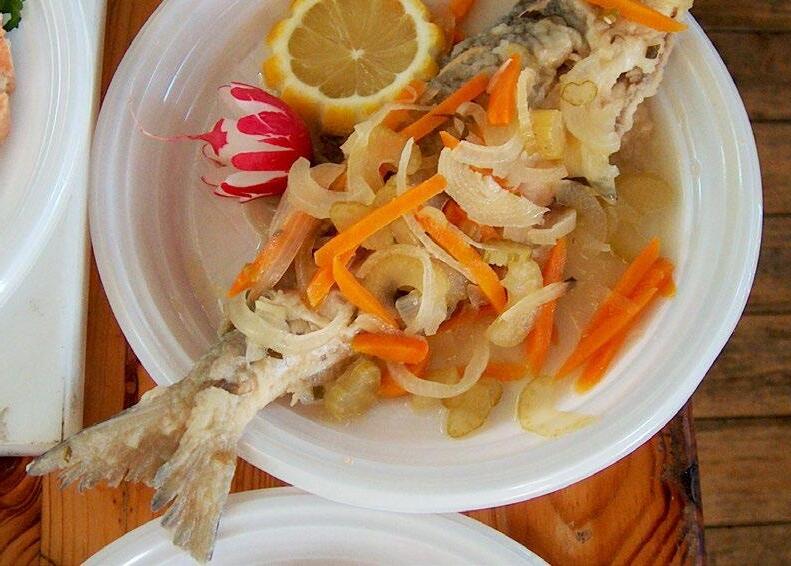
Ingredients
• 4 white fish fillets
• 100 g onion
• 50 g white celery
• 100 g carrot
• 100 g courgettes
• 300 ml white vinegar
• 300 cl white wine
• 150 g sunflower seed oil
• 50 g white flour
• 2 cloves of garlic
• 1 tablespoon of parsley
• Salt and pepper
Preparation
Wash all the vegetables and cut them into matchstick sized pieces. Put a little oil in a pot and add the onions, the other vegetables and the vinegar and wine. Bring to a boil and let cook for 4/5 minutes. In the meantime, clean the white fish fillets, dredge them in flour and fry them in a pan with the remaining oil. Remove them from the pan, dry and put them in a casserole dish that is big enough to hold them. Pour the boiling marinade over them, along with the vegetables. Let marinate for about 2 hours. Serve the warm fillets with their vegetable sides, 2 tablespoons of sauce and a drop of olive oil. The carpione marinade is very good when still warm, but it can also be served chilled, from the refrigerator.
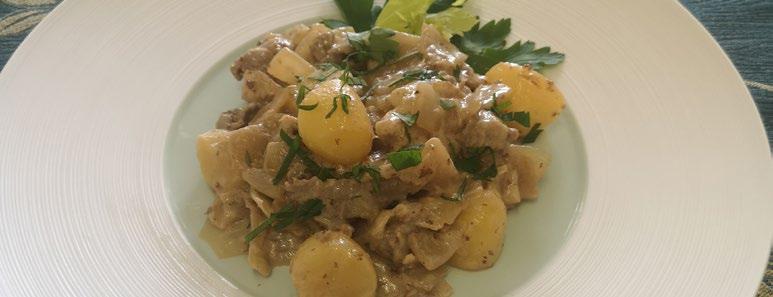
SECOND COURSE
Fricandò
Recipe for 4 persons
Ingredients
• 250 g veal rump
• 250 g chicken breast
• 200 g small potatoes (patate novelle)
• 200 g borettane onions
• 100 g butter
• 1 clove of garlic
• Water or vegetable broth as needed
• Salt and pepper
Preparation
Cut the veal rump and chicken breast into pieces. Clean the potatoes and onions. Melt the butter and gently sauté the garlic without browning it. Add the potatoes, onions, and meat. Brown everything well, then season with salt and pepper. Pour in enough water or broth to cover the ingredients. Bring to a boil and cook over a gentle heat. Serve piping hot.
A bit of history
A richer version of this dish, traditional of the village of Sordevolo, includes sausage, veal liver, pork rump, and mushrooms sautéed with garlic and parsley.
Biella
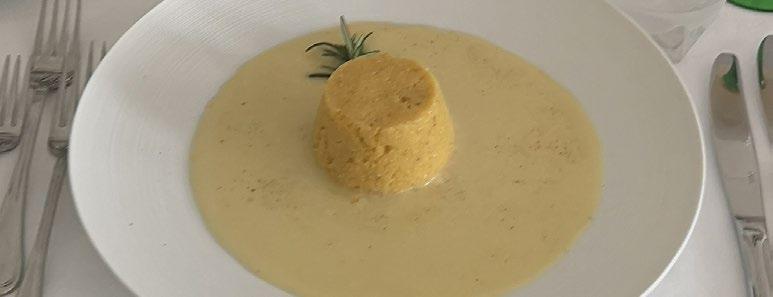
SECOND COURSE
Fricc o Mòja
Toma cheese fondue with polenta
Recipe for 4 persons
Ingredients
• 600 g full-fat Toma cheese (or 400 g full-fat and 200 g low-fat Toma for a stringier texture)
• 200 g butter
• 250 g whole cornmeal flour
• 1 clove of garlic
• Fine salt
Preparation
Boil 1 l of water with salt. Stir in the flour and cook over low heat for 1 hour. Remove the rind from the Maccagno cheese and cut it into cubes. Melt the butter in a small frying pan with the garlic clove and melt the cheese. Divide the polenta into 4 moulds or shape it using 2 spoons. Place the fondue on a plate or in a fondue bowl and top with polenta, serve piping hot.
Biella
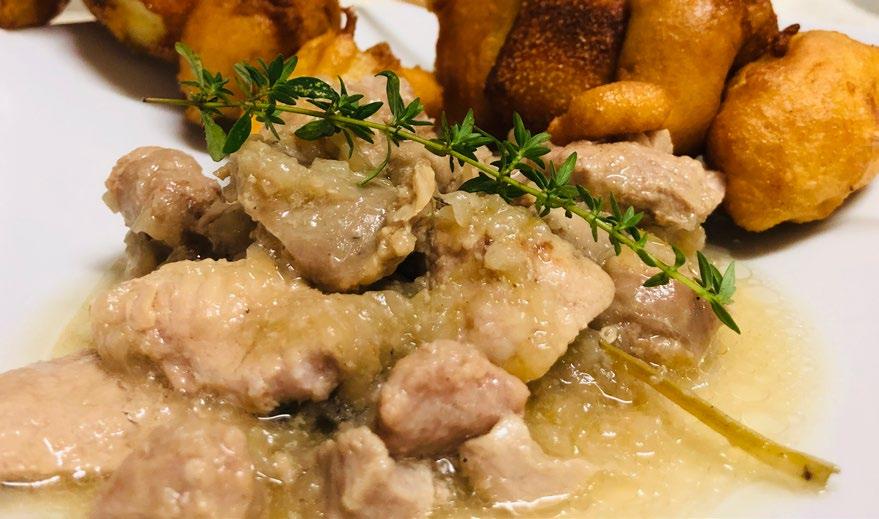
Ingredients
• 1 kg yellow onion from Cureggio and Fontaneto
• 300 g sausage
• 500 g pork loin
• 200 g pork culatello
• 100 g pork lung
• Colline Novaresi white wine
• Broth as needed
• Flavorings
• Salt
• Butter
Preparation
Peel the onions and cut them thinly, put them in a large pot with butter and flavourings and cook until soft. Cut up the meat, add the onions, the white wine, add the sausage and broth. Cook at a very low heat for 45 minutes and only season if necessary, stirring gently. If you like, you can also add pork lung (in this case cook the lung in water for 30 minutes. After that, you can slice it thinly and add it to the rest of the meat). This traditional dish can be accompanied by the fried part of semolina, apple, pear and amaretto.
Novara
Lakes
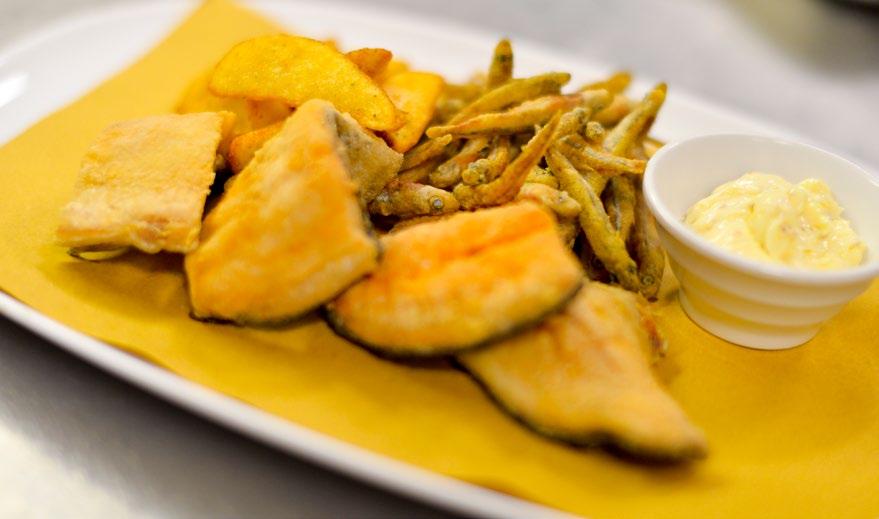
Ingredients
• 200 g fish per person (pink trout, white trout, white fish)
For the mayonnaise:
• 2 egg yolks
• 200 cl sunflower seed oil
• Juice from ½ orange and ½ lemon
• Salt
For the flour coating:
• 00 flour as needed
• Semolina flour as needed
• Rice flour as needed
Preparation
For the mayonnaise: prepare the mayonnaise by putting the yolks, salt and oil into a hand blender cup, whip and move the hand blender up slowly as the mixture increases in volume. When the mayonnaise has reached the right density, add the juice.
For the fried lake fish: fillet the fish and leave the skin on. Then cut the fillets into strips and dredge them in the coating made with the three types of flour. Fry them for a couple of minutes in oil at 180°C. Dry on paper towels and salt to taste. Serve hot with the citrus mayonnaise.
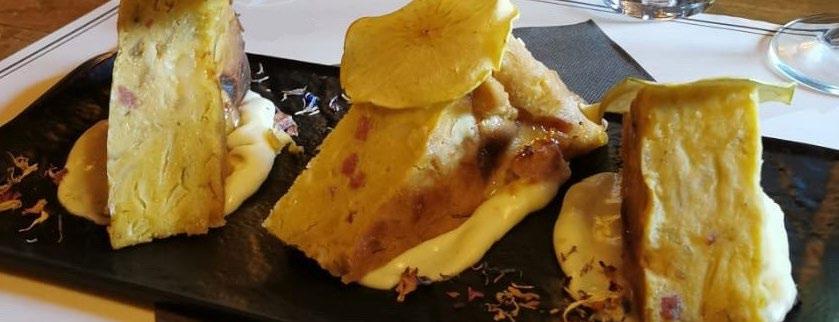
SECOND COURSE
Land Turta und wiweljeta
Recipe for 10 persons
Ingredients
• 150 g 00 flour
• 4 dl cream
• 200 g butter
• 120 g granulated sugar
• 5 dl red wine
• 90 g wholemeal maize flour
• 2 dl milk
• 6 g baking powder
• 60 g salami (salamella)
• 50 g Toma cheese
• 300 g apples
• 100 g dried figs
• 100 g sultana raisin
• 4 eggs
Preparation
Mix the flours together. Blanch the salami in boiling water for a few minutes, then cut into small pieces. Do the same with the cheese, apples, and figs. In a bowl, combine the eggs with part of the milk, add the flours and stir to obtain a smooth mixture. Dissolve the baking powder in a little warm water and mix it in, followed by the butter, salami, apples, and figs. The batter should have a soft consistency. Bake in a mould in a hot oven at 180° for 20 minutes. Serve with wiweljeta, a cream made of flour, butter, and milk with the addition of red wine.
Valsesia
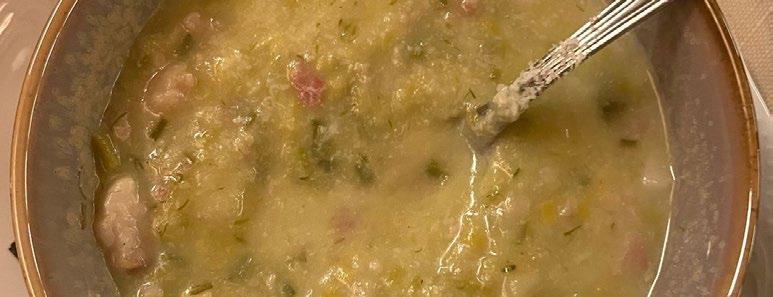
SECOND COURSE
Patati masarai
Recipe for 10 persons
Ingredients
• 800 g potatoes
• 300 g leeks
• 200 g streaky bacon
• 2 l water
• 80 g clarified butter
• Salt and pepper
Preparation
Peel and wash the potatoes, then cut them into uniform pieces. Clean the leeks and slice them into thin rounds. Cut the bacon into sticks. In a large pot, melt the butter and gently cook the leeks until softened. Add the bacon and cook until lightly browned. Add the potatoes and stir to combine. Pour in the water and bring to a boil. Add salt, reduce heat to low and continue cooking with the pan covered until the soup reaches a creamy consistency. Season with salt and pepper.
Valsesia
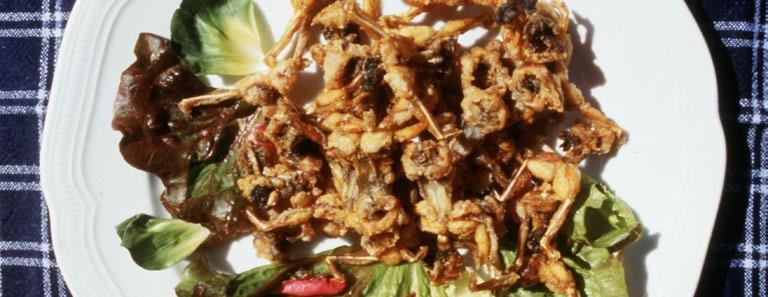
SECOND COURSE
Fried frogs
Recipe for 4 persons
Ingredients
• 600 g frogs
• 5 tablespoons of flour
• 1 glass olive oil
• 1 onion
• 2 tablespoons of white wine vinegar
• Juice of 1 lemon
• Salt and pepper
Preparation
Clean the frogs by removing the heads, bellies, and skin. Rinse under running water, then soak in fresh water with a splash of vinegar for 12 hours. Change the water and vinegar periodically. Marinate the frogs for another 12 hours in a mixture of olive oil, finely chopped onion and parsley, lemon juice, salt, and pepper. Dry frogs, dust with flour, and fry them in boiling oil. Once golden and crisp, drain on absorbent paper and serve them hot.
Vercelli
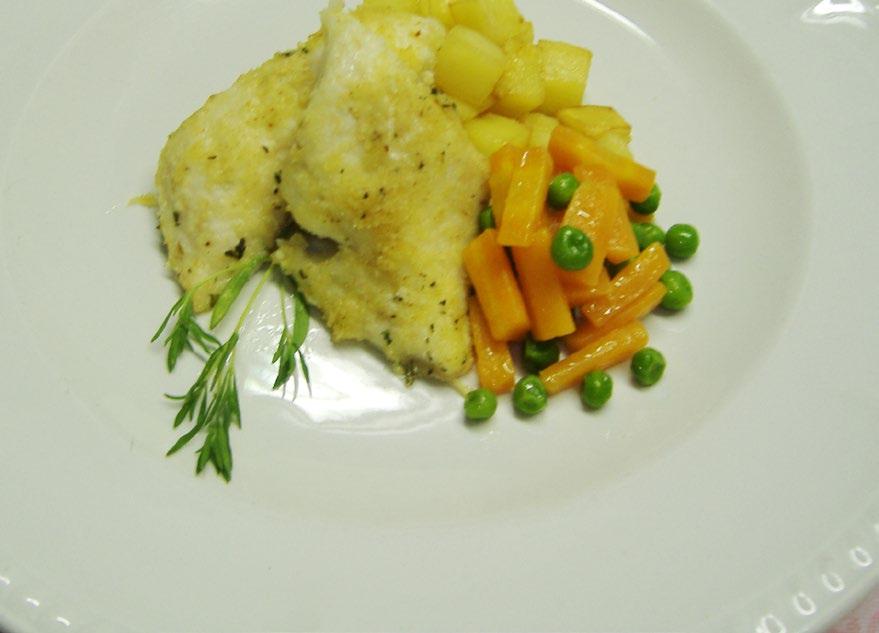
Lakes
Ingredients
• 900 g zander fillets (pike-perch) from Lake Maggiore
• 100 g breadcrumbs
• 125 g almond flour
• 10 g fine salt
• 30 g extra virgin olive oil
• A pinch of ground black pepper
• 1 sprig of rosemary
• 1 bunch of parsley
• 1 clove of garlic As a side dish:
• 200 g of green vegetables
Preparation
Mince the garlic, rosemary and parsley. Blend with the breadcrumbs, almond flour, salt and pepper. Put the fillets in a pan on baking paper, spread the breadcrumb-herb mixture evenly over the fish, drizzle with oil and bake in a preheated oven at 200°C for 20 minutes. Remove from the oven and serve hot with a side dish of green vegetables sautéed in butter.
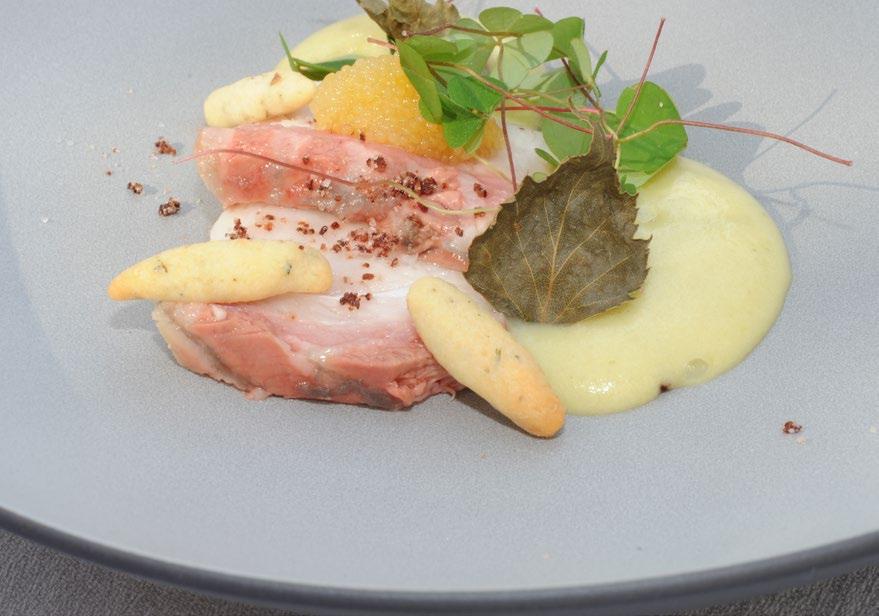
Lakes
Sturgeon in orange sauce with potato and wood sorrel cream and strozzo bread with juniper
Recipe for 6 persons
Ingredients
For the sturgeon:
• 1,3 kg sturgeon fillets
• 1 orange peel
• Extra virgin olive oil, to taste
For the potato and wood sorrel cream:
• 300 g boiled potatoes
• 150 ml whole milk
• 25 g butter
• 1 bunch of blanched wood sorrel
• Salt
For the strozzo bread with juniper:
• 125 g 00 flour
• 65 g cold butter
• 1 egg
• 2,5 g rock salt
• Juniper berries
Preparation
For the sturgeon: fillet the sturgeon, cut into pieces, put into sparkling water for 1 minute to achieve the correct level of acidification. Dry with paper towels. Place in vacuum bags with orange peel and extra virgin olive oil. Steam or cook with a Roner Clip for 20 minutes at 60°C.
For the potato and wood sorrel cream: boil the potatoes in salted water until they are done, then mash them. Add hot milk, wood sorrel and butter. Add the salt, whip and run through a sieve. Pour the hot whipped potato mixture into the siphon. Keep the siphon warm in a bain-marie (max 70°C).
For the strozzo bread with juniper: mix the flour, butter and salt with the juniper berries. Add the egg, form a ball and wrap in plastic wrap. Chill for 1 hour in the refrigerator. Form the strozzi (the shape is similar to that one of Italian gnocchi) and bake at 180°C for 10-15 minutes.
Approved by the Antica Cunsurtarija dal Tapulon
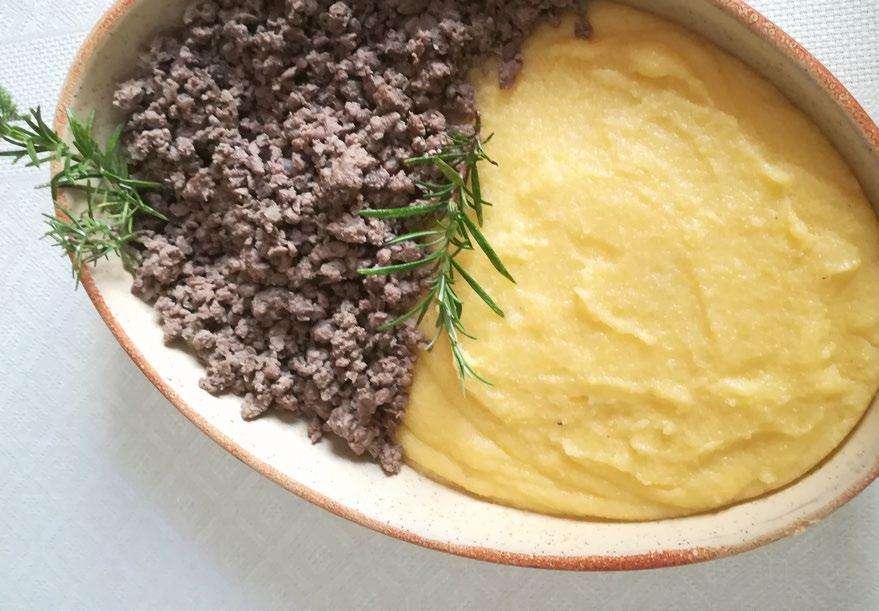
Ingredients
• 1 kg donkey meat, roughly ground
• 2 cloves of garlic
• 1 sprig of rosemary
• 2 bay leaves
• ½ l red wine (Boca DOC)
• 50 g lard
• 1 knob of butter
• 2 tablespoons of olive oil
• Salt and pepper
Preparation
Mince the lard on a chopping board with a heavy knife. In a pot place the lard, the oil, the smashed garlic, the bay leaf and the rosemary and gently brown. Once golden, remove the garlic, add the meat with salt and pepper, separating it with a fork, to make sure it doesn’t dry out. Add wine to cover the meat. When the wine is boiling, lower the heat. Cook on at low heat for about 45/60 minutes until the meat is quite dry. Season to taste with salt and pepper and add the knob of butter.
After removing the herbs, the bay leaves and the rosemary, serve the tapulone warm, with steaming polenta or stewed potatoes.
Novara
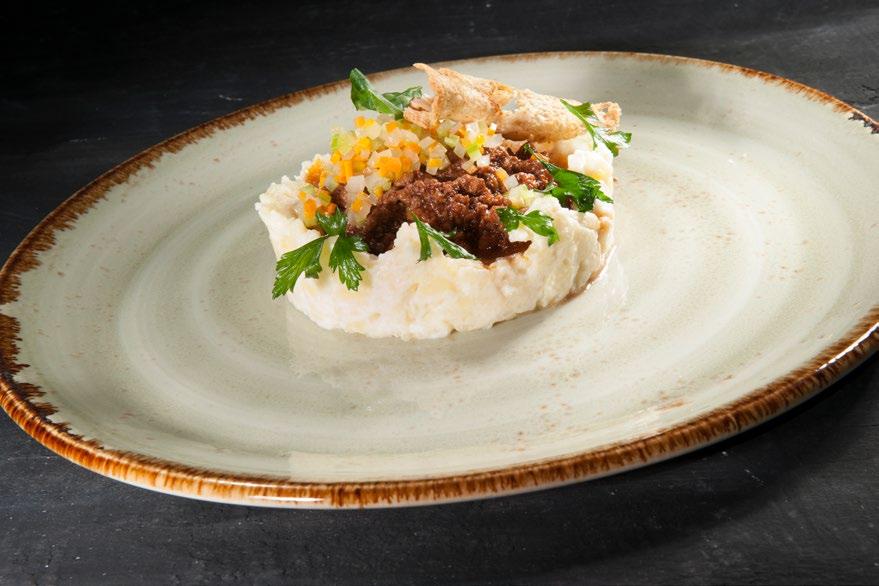
Tapulone carp stew, potatoes and milk
Recipe for 6 persons Lakes
Ingredients
For the tapulone (stew):
• 400 g ground carp
• 2 carrots brunoise
• 2 stalks of celery brunoise
• ½ white onion brunoise
• ½ cabbage julienne
• 2 bottles of red wine
• 2 cloves of garlic
• 1 bay leaf
For potatoes and milk:
• 600 g potatoes, sliced
• 200 g milk
• 50 g butter
For the basil extract:
• 40 g basil leaves
• 80 g oil
• 3 g iota
For the mirepoix:
• ½ carrot brunoise
• ½ onion brunoise
• ½ celery brunoise
• 1 clove of garlic
• 1 sprig of rosemary
For the wafers:
• “Torta del pane” (bread cake)
Garnish:
• Green pepper
Preparation
For the tapulone (stew): blanch the cabbage, fry the vegetables with the garlic. Sauté the carp to remove the fat. Bring all ingredients to a boil covered in the wine. Cook over low heat for 4 hours, and top up with wine as needed.
For potatoes and milk: combine the ingredients while cold with a little salt. Cook over low heat.
For the basil extract: centrifuge the basil, whip with oil and blend with the iota (thickener).
For the mirepoix: sweat the vegetables with plenty of oil for 5-10 minutes.
For the bread cake wafers: make the bread cake following the typical Ossola recipe (page 59); freeze the cake, slice it thin with a slicer, roll the slices into spirals around cannoli tubes (or similar) and bake for 100°C for 30 minutes.
Garnish: use a food ring mould to set the potatoes in the centre of a shallow bowl. Place the tapulone at the centre of the potatoes, spread the basil and fried mirepoix over the dish. Grate a little green pepper and set the wafer on the tapulone.
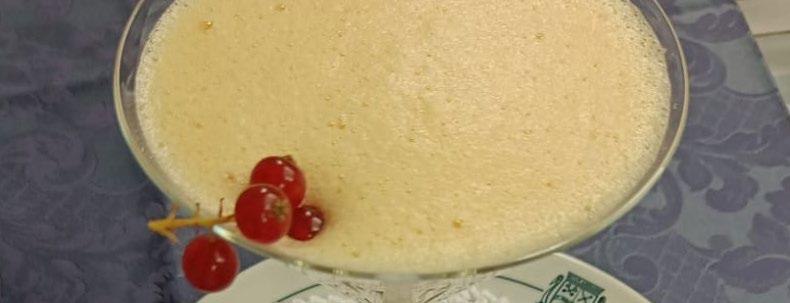
DESSERT
Arsumà
Recipe for 10 persons
Ingredients
• 10 eggs
• 100 g granulated sugar
• 150 ml red wine
Preparation
Separate the yolks from the whites. Whisk the yolks vigorously with the sugar until light and frothy. Whip the egg whites until stiff, incorporate them into the yolks and add the wine. If desired, Chinato red wine can be used. Arsumà is traditionally served with Crevacuore canestrelli biscuits.
Valsesia
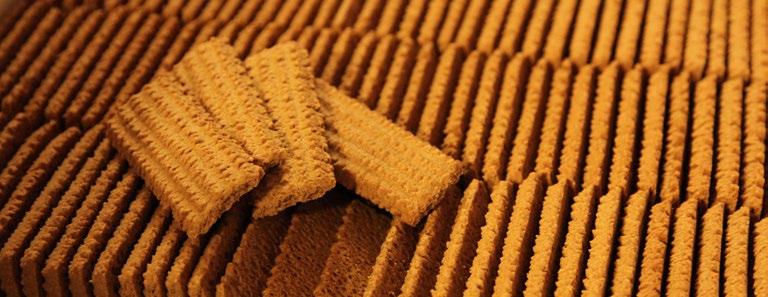
Bicciolani, the biscuit of Vercelli
Recipe for 4/6 persons
Ingredients
• 250 g 00 flour
• 100 g granulated sugar
• 180 g butter
• 2 eggs
• Mixed spices (cloves, nutmeg, cinnamon, a pinch of pepper)
Preparation
In a planetary mixer fitted with a paddle attachment, beat the butter, sugar, and eggs until frothy and smooth. Add the sifted flour and finely ground spices. Once the dough is ready, cover it with cling film and refrigerate for at least 2 hours. Transfer the dough into a piping bag fitted with a serrated rectangular nozzle. Pipe cookies about 8 cm long. Refrigerate again to firm up the butter before baking—this helps retain their shape. Bake at 180°C for around 10 minutes, or until the kitchen is filled with the warm aroma of spices. Enjoy it with a traditional zabaglione, a tea, or chocolate.
A bit of history
These biscuits were first documented in the Renaissance. Documents from the 17th century mention spiced biscuits known as bicciolani. However, the modern bicciolani (still popular among the locals) became famous thanks to Carlo Provinciale, who began making them in 1803 under La Torre dell’Angelo in Vercelli. Some variations include corn flour, a nod to historical culinary adaptation and taste.
Vercelli
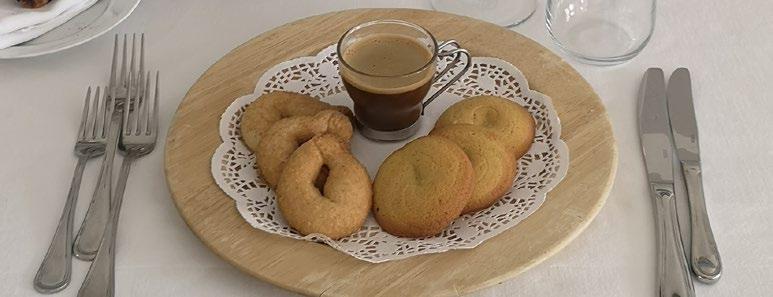
DESSERT
Paciarèt, Torcit e Paste ‘d Melia
Coffee with egg yolk, butter torcetti, and cornmeal biscuits
Recipe for 4/6 persons
Ingredients
For the coffee:
• 4 moka-pot cups of coffee
• 4 egg yolks
• 4 tablespoons of sugar
• ½ cinnamon stick
For the butter torcetti biscuits:
• 125 g 00 flour
• 60 g butter
• 60 ml water
• 40 g granulated sugar
• 3 g brewer’s yeast
• Fine salt
• Brown sugar, for coating
For the paste di meliga:
• 100 g 00 flour
• 100 g butter
• 75 g granulated sugar
• 50 g fine cornmeal
• 2 egg yolks
• 2 g vanilla yeast
• Lemon zest
• Fine salt
Preparation
For the butter torcetti biscuits: dissolve the brewer’s yeast in water. Add the granulated sugar, flour, and salt. Knead until smooth, then let rest in a warm place for 1 hour. Cut the roomtemperature butter into cubes, kneading until well blended. Refrigerate for 1 hour, then divide into pieces of about 15 g and roll into sticks. Roll the sticks in the brown sugar and close them by joining the ends. Bake at 170°C for 12 minutes or until golden brown. Cool completely before storing in a tin.
For the paste di meliga biscuits:
cream the butter and sugar with an electric whisk. Add the egg yolks and mix. Combine the flours, yeast, salt, and lemon zest. Add to the butter mixture and knead well. Transfer to a piping bag with a ridged nozzle. Pipe 12 cylinders of about 10 cm. Fold into a ring, place on a baking tray with baking paper and bake at 170°C until golden brown. Cool completely before storing in a tin.
Coffee:
cream the egg yolks with the sugar. Heat the coffee with the cinnamon and add it to the cream, stirring to dissolve the sugar. Pour into 4 glass cups or small glasses and serve accompanied by biscuits.
Biella
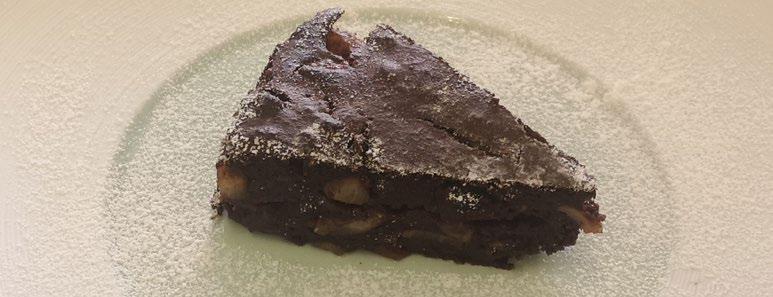
DESSERT
Palpitòn
Recipe for 4/6 persons (for a 28 cm diameter cake tin)
Ingredients
• 1 kg hard-boiled pears
• 300 g stale white bread
• 150 g amaretti biscuits
• 150 g sugar
• 150 g butter
• 50 g bitter cocoa
• 50 g raisins
• 3 eggs
• 1 lemon
• 1 shot of Fernet (bitter Italian amaro)
Preparation
Peel, core, and dice the pears. Melt 100 g of butter, add the pears, 100 g of sugar and grated lemon peel. Cook over a gentle heat until the pears are soft and dry. Soak the bread in cold water, squeeze it and crumble it. Add the crumbled amaretti biscuits, cocoa, raisins, cooked pears, Fernet and eggs. Mix thoroughly and pour into a buttered cake tin. Dot with remaining butter and sprinkle with the remaining 50 g of sugar. Bake at 160°C for 1 hour. Let cool, unmould, and serve warm.
A bit of history
Palpitòn is a traditional dessert from Curanuova in Mongrando, typically prepared for Mid-August.
Biella
Ingredients
For the shortcrust:
• 250 g 00 flour
• 150 g softened butter
• 100 g granulated sugar
• 1 egg
• ½ pod of vanilla, seeds
• Grated lemon zest
• 1 pinch of salt
• 1 teaspoon of baking powder
Preparation
For the shortcrust:
create a well with the flour and add the sugar and a pinch of salt. In the center of the well, shred the butter, add the egg, the baking powder, the lemon zest and the vanilla pod seeds. Mix everything quickly, working the dough with your hands. When the dough is smooth and uniform, make a ball and place it in the fridge to rest for an hour.
For the filling:
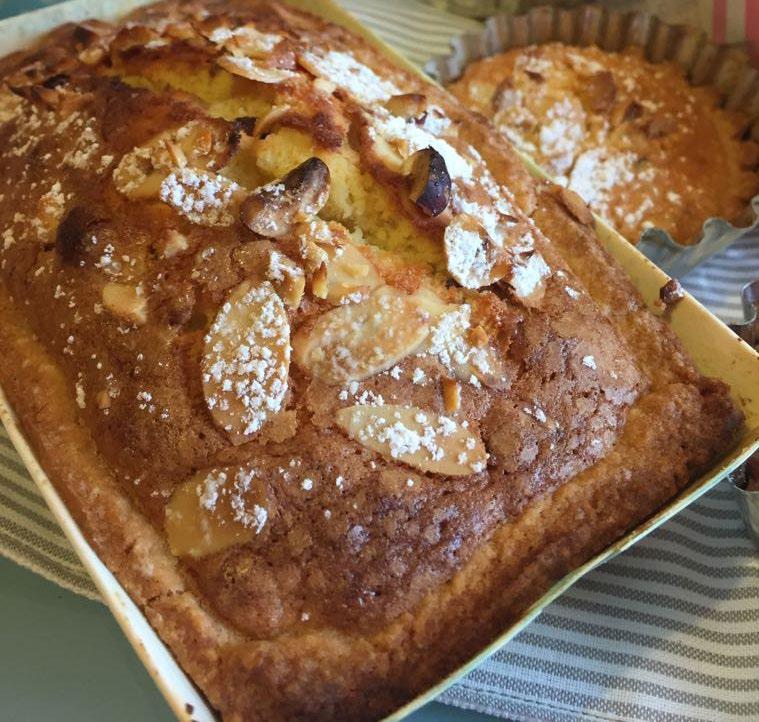
For the filling:
• 130 g 00 flour
• 130 g granulated sugar
• 100 g candied chestnuts
• 75 g melted butter
• 4 eggs
• 1 teaspoon of lemon juice
• 1/2 pod of vanilla, seeds
• 1 handful of hazelnuts, almonds, pine nuts
beat the egg whites to stiff peaks, adding a teaspoon of lemon juice and in a different bowl, beat the yolks with sugar. Add the egg yolks to the whites, folding gently. Add the flour, the candied chestnuts that have already been chopped, the melted butter and the vanilla pod seeds.
Take the pastry from the fridge and roll it out to a thickness of 4 mm. Butter and flour a loaf pan and place the pastry in it. Add the filling, cover the chopped hazelnuts, the almonds and pine nuts.
Sprinkle with powdered sugar and cook in a 190°C oven for about 45 minutes.
Novara
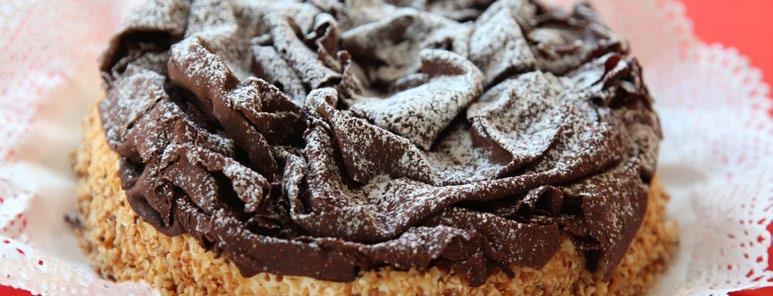
Tartufata
Recipe for 4/6 persons
Ingredients
For the sponge cake:
• 5 eggs (approx. 250 g)
• 125 g granulated sugar
• 125 g 00 flour (or a mix of flour and potato starch)
• Aromas - vanilla and lemon zest
For the custard:
• 250 ml milk
• 250 ml cream
• 4 egg yolks
• 70 g granulated sugar
• 25 g cornstarch
• Aromas - vanilla and lemon zest
Optional:
• 30 g hazelnut cream
For decoration:
• 150 g dark chocolate
• 35 g butter
• Hazelnuts
For the syrup:
• 100 ml of water
• 80 g sugar
• 40 ml of rum
Preparation
For the sponge cake: whip the eggs with the sugar in a planetary mixer, add the aromas. Pour in the sifted flours with movements from the bottom to the top (to avoid deflating the mixture). Pour into a buttered and floured baking tin and bake for 25/30 minutes at 175° C (static oven).
For the custard: bring the milk and cream with flavourings to a boil. Separately, beat the eggs with sugar and cornstarch. Combine mixtures and cook on the fire until thickened. Cover with cling film and cool quickly.
For the syrup: bring the water to the boil and melt the granulated sugar. Finally, add rum or maraschino liqueur for an alcoholic note.
For the external decoration: melt the dark chocolate with the butter in a bain-marie. Spread a layer on a sheet of baking paper, let cool and solidify at room temperature or in the refrigerator. Once the mixture has cooled and hardened, cut out chocolate curls using a potato peeler and/or a smooth-bladed knife.
Assembling the cake: cut the sponge cake into 3 thin discs. Place the base layer in a springform pan to make it easier to assemble the cake. Brush with syrup and spread part of the cream on the first layer. Top with a second layer of sponge cake and brush with syrup before covering with more cream. Close with the last disc and brush with the last remaining amount of syrup. Cover the cake with a thin layer of cream to help the hazelnut crumbs on the edges and chocolate curls on the top stick.
Vercelli
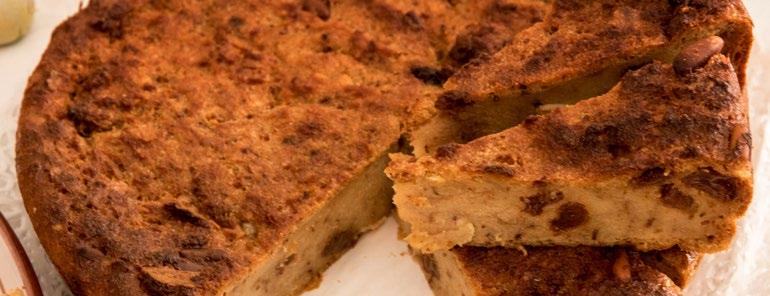
DESSERT
Torta del Pane
Bread cake
Recipe for 4/6 persons
Ingredients
• 300 g stale bread
• 1 l milk
• 150 g raisins
• 1 cup of amaretto or rum (optional)
• 3 eggs (beaten egg white, optional)
• 200 g sugar
• Mix of spices La Saporita (optional)
• Lemon zest
• Cinnamon
Preparation
Remove the crust from the bread and soak it in the milk along with sugar (the density of the mixture depends on how stale the bread is). Then, whisk vigorously and break it into small pieces. Add the remaining ingredients and pour everything into a baking tin. Bake in a static oven at 145° for 1 hour.
Ossola Valleys
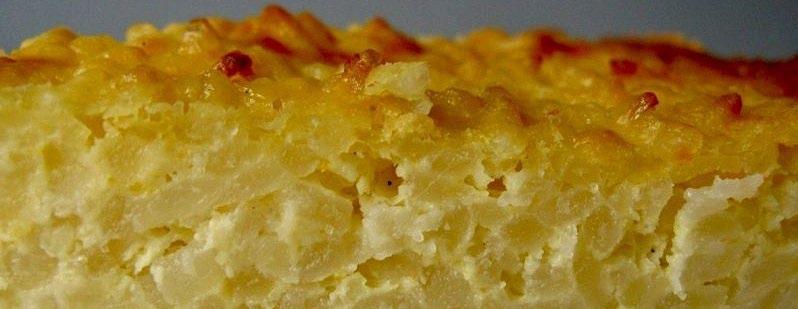
Rice cake
Recipe for 4/6 persons
Ingredients
• 1,5 l milk
• 250 g rice
• 100 g granulated sugar
• 2 eggs
• 8 g baking powder
• Aromas - vanilla and lemon zest
Preparation
Bring the milk to a boil with the sugar and flavouring. Add the rice and cook for 25 minutes, until a soft risotto is obtained. Transfer the mixture to a bowl and stir with a whisk to help it cool completely. Add the eggs to obtain a creamy batter. Pour the mixture into a buttered cake tin dusted with rice flour and bake at 160° C for 45 minutes. Dust with icing sugar and serve.
Vercelli
Between Monte Rosa, the Lakes and the Lands of Northern Piedmont. Flavours of excellence
The Biellese area
The subject of renewed interest by local and nonlocal entrepreneurs, the Biella wine sector is one of the excellences of the territory. The hills of Eastern Biellese are the production areas of Lessona, Bramaterra, and Coste della Sesia: DOC wines based on Nebbiolo vines, rich in flavour, history, and tradition. Other historic production areas are Vigliano and Castellengo: here farms are often located in castles and historic mansions; on the other hand, Erbaluce DOCG and Canavese DOC are produced on the slopes of the Serra hill and around Lake Viverone.
For beer lovers, the Menabrea brewery is an artisanal and entrepreneurial success story alive in the area since 1846; also, not to miss are the many artisanal microbreweries, with workshops scattered throughout the area and sales and tasting points in the historic city center.
The “Bolle di Malto” beer festival, a review of craft breweries, street food, and live music held in Biella’s historic center, is an eagerly awaited Biella August event.
And it is precisely the water with which these beers are produced that plays a very important role in the identity of the Biellese territory: an essential element of the landscape, it is indispensable with its purity and lightness - it is considered the lightest water in Italy - for the quality of Biellese textiles but also for agri-food production. “Lauretana” mineral water, an internationally known brand, is bottled in Valle Elvo. Also worth mentioning is Ratafià di Andorno, a sweet liqueur made from the alcoholic maceration of wild cherries, and Vermouth, invented in 1786 by the Biellese distiller and herbalist Antonio Benedetto Carpano, born in the village of Bioglio, who transformed a medicine into a convivial aperitif.
Biellese cuisine originates from the tasty mountain and peasant tradition. The typical dish par excellence is polenta concia, a fluid cream of corn cooked for a long time in the copper pot and flavoured with lightly aged cheese and plenty of farmhouse butter. Dedicated to this classic of Biella cuisine is “Ben Cuncià”, a festival that involves restaurants throughout the area and takes place in early November.
Riso di Baraggia Biellese e Vercellese DOP, Italy’s first and only PDO rice, produced in the expanses of the agricultural plains bordering the province of Vercelli, is perfect for making riso in cagnone: a typical winter dish rooted in traditional mountain Biella, prepared with boiled rice, fat Toma cheese, and sizzling butter.
Another delicacy is capunèt, rolls of cabbage or, chard leave stuffed with meat, vegetables, and cured meats. Finally, among desserts, of note are the typical canestrelli biellesi, cookies made up of two wafers stacked on top of each other, filled with
chocolate, but also torcetti, paste di meliga, and honey. Among cheeses, not to miss is the Toma Biellese, made from both whole milk and semi-skimmed milk (the latter, called Toma magra is typical of the Elvo and Oropa Valleys), and then Maccagno, named after an alpine pasture located at almost 2.200 m above sea level in Valsesia but which has been used by Biellese mountain people for centuries. The dairy production also includes excellent goat’s cheeses, and it is all to be discovered in the local food shops and markets. Among cured meats, besides the many salamis, not to miss is the paletta di Coggiola, pork shoulder encased in the bladder, perfect accompanied by mostarda di mele, an apple chutney which goes also well with cheese and polenta.
The Novarese area
Novara and its territory are a land of rice, of wine and of Gorgonzola. And these main products are joined by many others that are no less an important part of our most typical traditions.
There are many varieties of rice produced in the Bassa lowlands, all able to satisfy even the most demanding palates. Carnaroli classico, Razza77, Maratelli, Roma, Vialone Nano: all names that immediately recall the idea of a steamy risotto, prepared with all the blessings: above all, the main ingredient, which has to be top quality, better still if it comes from one of the many agricultural manufacturers. Firstly, because you can see the rice paddies themselves, and also because it is actually quite surprising to find out just how rice is cultivated and processed, and the producers are proud to tell you all about how the magic happens, from the field to your table. Thus, rice becomes a pretext to discover the other products necessary to make a good risotto: for example, onion. Ours are sweet and yellow and a few years ago joined the Slow Food Organisation; it is strictly cultivated in the municipalities of Cureggio and Fontaneto, it is rather flat in shape, can weigh up to 400 grams and can be stored for a long time. Excellent not only in risottos, but also in soups or baked. Or saffron, a very precious spice that makes every dish unique. Its cultivation has found new ground in the Novara area in recent years, yielding excellent results. As well as Novara’s traditional rice, since the late 1990s the area has also produced black aromatic rices, Venere and Artemide which are more suitable for salads or
with fish. The king of cheese, Gorgonzola Dop, finds in Novara the headquarters of its Protection Consortium and the area is the ideal place for its production. Both the sweet and natural (or spicy) products are made with pasteurised cow’s milk which is mixed with penicillium spores which react to the air to form the blue veins that are characteristic of this process. Once upon a time, the whole family would get together to butcher the pig which – according to tradition – would leave nothing unused, and which gives us our most famous cured meats: salam dla duja and fidighin, both made with pork meatfidighin with liver – and are stored under fat (historically in the duja, a terracotta jug) in order to better preserve its soft texture. Together with rice, these meats are the main ingredients of our most typical recipe, paniscia, a very rich risotto with beans, a mixture of salami and lard, greens and various vegetables; there is no actual official recipe as basically every family has its own. Novara’s meat dishes tend to be based on beef, pork or horse meats: such as for example tapulone, typical of the Borgomanero area, made with finely chopped donkey meat cooked on a low flame with seasonings and red wine and then served with polenta. Or even the frittura, a hearty fried dish combining pork loin, sausage, onions, and cabbage. Biscuits are the sweets that clean the palate after a local meal: “brutti ma buoni” from Borgomanero, biscottini from Novara, “busarola” from Romagnano Sesia, “beatine” from Ghemme, those made with white or black rice flour… there is something for everyone! Some are made with honey produced on our hills, where the beekeepers place hives during the flowering periods of chestnuts trees, black locust trees and other native plants. And to wash it all down with? The area is home to a vast range of Nebbiolo-based wines, the king of the Piedmont grape, which used pure or in a blend of native grapes (Vespolina and Uva Rara) give birth to the DOCs and DOCGs of the Novara hills. Boca DOC, Fara DOC, Sizzano DOC and Ghemme DOCG are the most representative of the area. Fun fact: Campari, one of the most famous aperitifs in the world, was invented in Novara in the Bar dell’Amicizia where Gaspare Campari perfected the recipe in 1860.
cereal that triumphs in the Panissa, the most typical of Vercelli’s risottos, accompanied by beans, pork rinds, chopped lard, herbs and salam d’la duja. However, it is not the only product that makes agriculture and local cuisine great. Equally inviting and tasty are the non-rice dishes, such as fagiolata, a typical dish of the carnival period (the greatest Italian carnival is held in Santhià) or frogs, cooked in a variety of ways.
To end the meal on a sweet note, you can choose between the delicate shortcrust pastry of the Bicciolani or the soft Tartufata truffles. The former are crumbly biscuits flavoured with cinnamon, cocoa and cloves. Their unmistakable taste and name, the same as the city’s carnival mask, make them the symbol of Vercelli. The latter is a sponge cake filled with a soft Chantilly cream and garnished at the base with hazelnut grains, covered with fluffy chocolate ribbons dusted with icing sugar.
Those who choose to visit Vercelli’s rice fields have the opportunity to come across a multitude of farms and rice mills, which have been dedicated for generations to rice cultivation and processing, immersed in unique environments rich in history. Visitors can buy and taste excellent varieties of rice and learn all the secrets of its cultivation.
The first and only Italian PDO rice is produced in the Baraggia area, on the border between the Vercelli and Biella area. Its excellence is recognised by leading Italian and international chefs who represent the highest expression of the area’s great rice-growing tradition: Baraggia Biellese and Vercellese rice.
The Valsesia and Vercellese area
Discovering the food and wine flavours of the province of Vercelli is an unforgettable experience, a wonderful journey capable of surprising all palates, even the most refined. The true king of the Vercelli table is rice, a versatile
Moving from the plains to the hills, the border between the provinces of Biella and Vercelli is a succession of splendid views, picturesque villages, and renowned wineries where one encounters another great excellence: wine. These are the Lands of Nebbiolo; a vine whose grapes produce full-bodied and long-lived red wines, but above all wines skilfully combined with traditional dishes. The hilly area in the province of Vercelli, between the municipalities of Gattinara, Lozzolo, and Roasio, produces some of the best red wines in Italy in terms of quality, delicacy, and harmony: these are Gattinara DOCG, Bramaterra DOC, and Coste della Sesia DOC. Precisely its particular geographic position is one of the main secrets of the success of its wines: the mild climate the vineyards are exposed protected from the cold north winds by Monte Rosa, but also the presence of the Sesia Supervulcano, they have proved to be ideal conditions for the cultivation of a Nebbiolo DOCG of excellence such as ‘Gattinara’. Visiting one of the wineries that have been dedicated to wine-growing for generations is the best way to taste excellent wines
and learn all the secrets of their production. Also definitely worth mentioning is the Enoteca Regionale di Gattinara e dell’Alto Piemonte, which was set up in 1999 to relaunch and protect local wines: an objective that complements a broader project aimed at enhancing the area’s gastronomic tradition and highlighting its historical, social and cultural peculiarities. Flavours also change as the altitude rises. In Valsesia, the cuisine is made up of decidedly substantial dishes, created to face the rigours of the winter climate. A few examples? The well-known polenta concia and capunèt, simple rolls made with endive or Savoy cabbage leaves and a generous filling. The pure air of the “greenest valley in Italy” yields the Toma valsesiana, a typical hard or semisoft cheese. There are several varieties, both fresh and mature, flavoured with a particular ageing process or with spices, garlic and chilli pepper.
Do not miss the straccetti and mocetta, a chamois leg processed like raw ham and served in very thin slices, masarai potatoes, turta d’Alagna or uberlekke, a boiled meat Walser recipe prepared with different types of salted meat.
And how can we not mention the miacce? It is hard to say whether they are sweet or savoury. These simple waffles, very thin and crispy, genuine and mouthwatering, pair well with everything, including honey, Gorgonzola, jams, speck and Nutella but, above all, with the Toma valsesiana cheese.
The Lakes and the Ossola Valleys
A delight for the eyes, the lakes of Piedmont and the Ossola Valleys, but also for the palate!
Come and visit local shops, restaurants and “vacation farms” or participate to the country events held along the lakes, on the hills and up in the mountain, where one can enjoy the typical dishes from Ossola, prepared following the ancient traditional recipes and especially using exclusively genuine ingredients! Some examples? Black bread with rye flour: the type prepared in Coimo has always been a favorite even though this bread is generally produced in the entire Ossola region. The “Crescenzin” from Ossola is instead a sweet black bread with walnuts, raisins and figs.
As for first courses worth mentioning are the “gnocchetti all’ossolana”: home-made dumplings prepared with potatoes, chestnut flour and pumpkin flavoured with butter or local cheese cream and small dice of lard. Ossola is also known for its unique or even rare cured meats, such as the “Violino di Capra” (whole air-dried leg of goat shaped like a violin), the raw ham of the Vigezzo
Valley (a real treat reminiscent of the resinous scent of the forest), the “Brisaula Val d’Ossola” (especially lean meat steeped in wine, then seasoned with spices and air dried) and the lard seasoned with herbs and spices. A wide variety of cheese is also produced in this area, i.e. the Ossolano DOP, the unique Bettelmat produced exclusively in seven pastures of the Antigorio-Formazza Valleys or the “Toma of Mottarone” produced up among the tallest peak between Lake Orta and Lake Maggiore. Why not savor then such specialties accompanied by various types of honey from Lake Maggiore and the surrounding valleys? Lakes Maggiore, Orta and Mergozzo are home to a great variety of fish: trout, baked in tinfoil wrapping and seasoned with herbs; perch and white fish, “lavarello” or “coregone”, usually fried or soused; then pike, brook trout, gardon and bleak. Very often lake fish is used to prepare and flavour first courses too, like the risotto.
Absolutely a “must” of the most typical Piedmontese menus is “polenta” that can be served alone, mixed with cheese or added to pork meat (spare ribs and small salami) and mushrooms (boletus is the finest species) gathered in autumn on the hilly or mountain areas of the territory. Taste the local delicacies even more with the “heroic” Ossola wines: among the terraced vineyards in the north of the Toce plain, the “Valli Ossolane” DOC Nebbiolo is produced from the indigenous ecotype known as “Prünent”.
There is also a wide choice of baking products: “Imperialine” and “Reginette” biscuits of Omegna, “Margheritine” biscuits of Stresa, “Fugascina” biscuit of Mergozzo, “Intresine” from Intra and “Amaretti” biscuits of Pallanza. On the Lake Orta the “Pane di San Giulio”, rye bread filled with walnuts, raisins and/or chocolate, is prepared fresh on the Saint’s patron Feast on 31st January. The “torta del pane e latte” is a typical mountain cake made with bread, fresh milk, cocoa powder and raisins, then baked in a traditional terracotta pan and sometimes decorated with pine kernels and rosemary or bay leaves. Citrus fruit cultivations are common in the northern end of Lake Maggiore: lemons, oranges, citron, and grapefruit are used to make cakes, teas, liqueurs and jams. Among these is the Canarone, an ancient hybrid lemon-citron fruit, indigenous to Cannero Riviera, which can be enjoyed fresh or as marmalade. Its candied peel has a slightly pungent aromatic flavour.
Last but certainly not least is our water. Excellent mineral water flows from the several natural springs of Ossola. For example Crodo (Antigorio Valley), where famous non-alcoholic Italian aperitif drink “Crodino” (Campari Group) was created, Bognanco (Bognanco Valley) and Vigezzo (Vigezzo Valley).
DISCOVER OUR PRODUCERS

Producers of Biella

Producers of Vercelli

Producers of Novara

Producers of the Lakes and the Ossola Valleys

Producers of Valsesia

Consorzio Tutela
Nebbioli Alto Piemonte
Acknowledgements
For the kind concession of the recipes and for the consultancy we thank:
the Associations:
Cooking For Alps
Cuochi Alto e Basso Novarese
Gente di Lago e di Fiume
Sagre dell’Ossola
Antica Consurtarija del Tapulon
Pro Loco di Cameri
Pro Loco di Fontaneto d’Agogna
Presidio Slow Food Colline Novaresi
Risicultori di Razza
the Restaurants:
Ristorante Divin Porcello - Masera (VB)
Ristorante Tantris - Novara
Ristorante Le Colonne - Santa Maria Maggiore (VB)
the High Schools:
IPSSEOA “S. Ronco” di Trino Vercellese (VC)
IPSEOA “G. Pastore” di Varallo (VC)
Biella recipes were adapted by Upper Secondary School Institute “G. Aulenti” in Biella, and taken from “L’an-cà da fé –La casa del fuoco. L’antica cucina biellese” di T. Burat e G. Lozia
(De Alessi Ed., Biella 1989)
For the kind cooperation we thank the Chamber of Commerce of Monte Rosa, Lakes and Northern Piedmont
While every effort has been made to ensure the accuracy and reliability of this publication, the authors and publisher accept no liability for any errors, inaccuracies, or damages resulting from the use of this content, including unintended typographical or printing mistakes.
Photos
Archivio Distretto Turistico dei Laghi
Archivio ATL Terre dell’Alto Piemonte Biella Novara
Valsesia Vercelli
Cooking For Alps
Cuochi Alto e Basso Novarese
Gente di Lago e di Fiume
Sagre dell’Ossola
Marco Benedetto Cerini
CMVV
Marco Garrone
Giancarlo Parazzoli
Ristorante Divin Porcello di Masera (VB)
Hotel Ristorante Montagna di Luce di Alagna (VC)
Istituto IPSSEOA “S. Ronco” di Trino Vercellese (VC)
Istituto di Istruzione Superiore “G. Aulenti” di Biella
Filippo Fossati
Translations
Way2Global srl - Milano
Graphic project
Mauro Grosso
Grafica Novarese snc
This brochure was produced as part of the project “Food & Wine – “Flavours of excellence between Monte Rosa, the Lakes and the Lands of Northern Piedmont”, in accordance with Regional Law no. 14/2016, art. 21 – Year 2024/25
ATL DISTRETTO TURISTICO DEI LAGHI infoturismo@distrettolaghi.it www.distrettolaghi.it
ATL TERRE DELL’ALTO PIEMONTE info@terrealtopiemonte.it www.terrealtopiemonte.it





terrealtopiemonte.it distrettolaghi.it
Biella pastures – Oasi Zegna
Lake Maggiore and its valleys
Walser huts - Alagna Valsesia (VC)
Rice fields and Cupola di San Gaudenzio - Novara
Principato di Lucedio - Trino Vercellese (VC)
